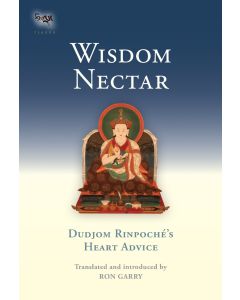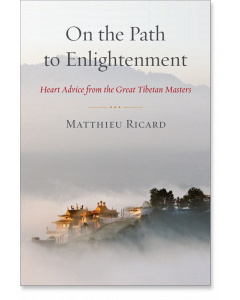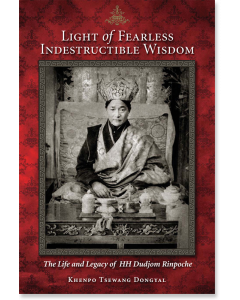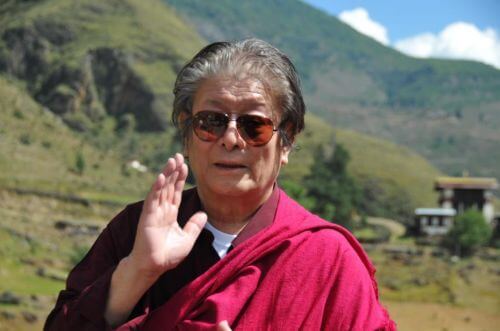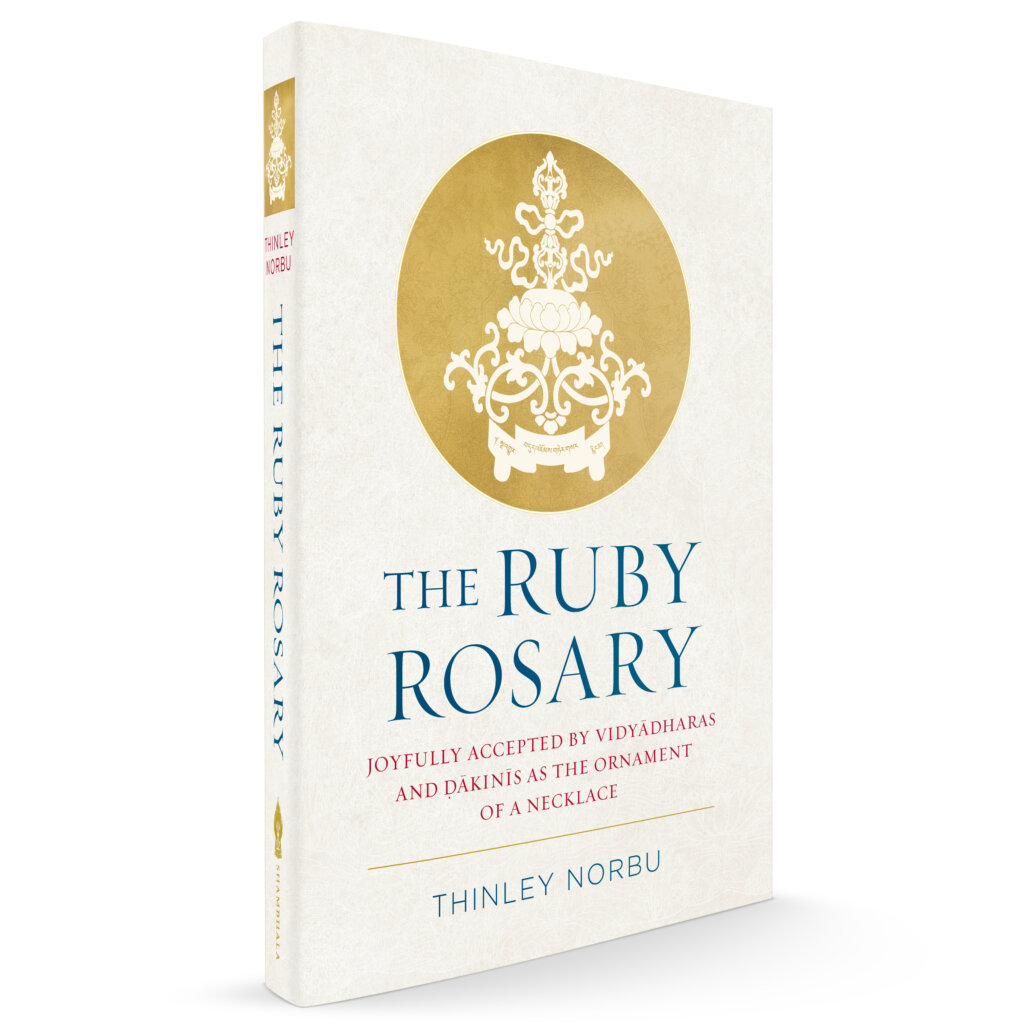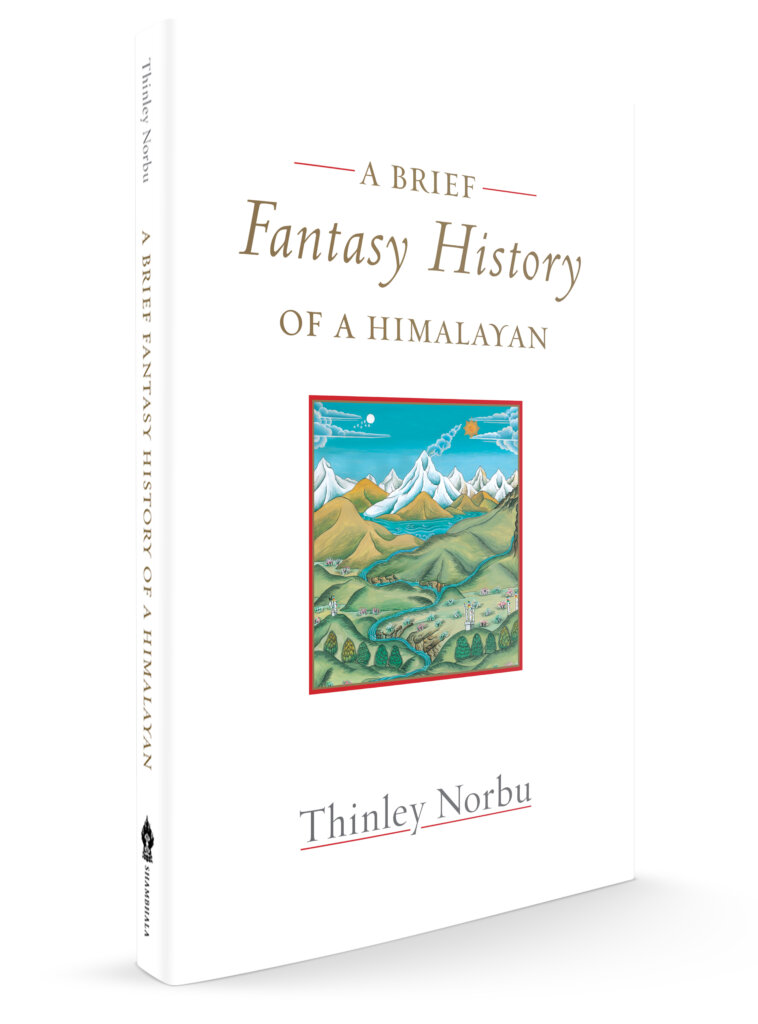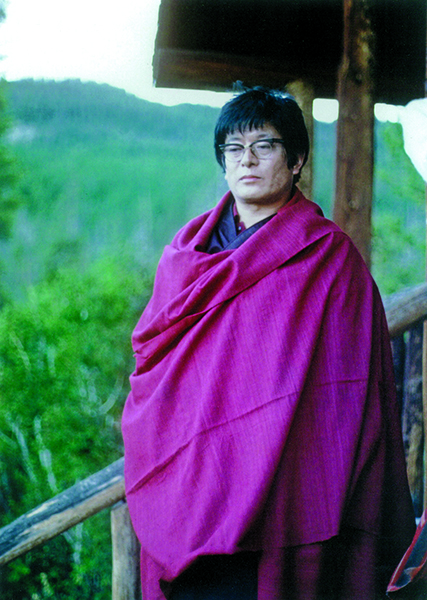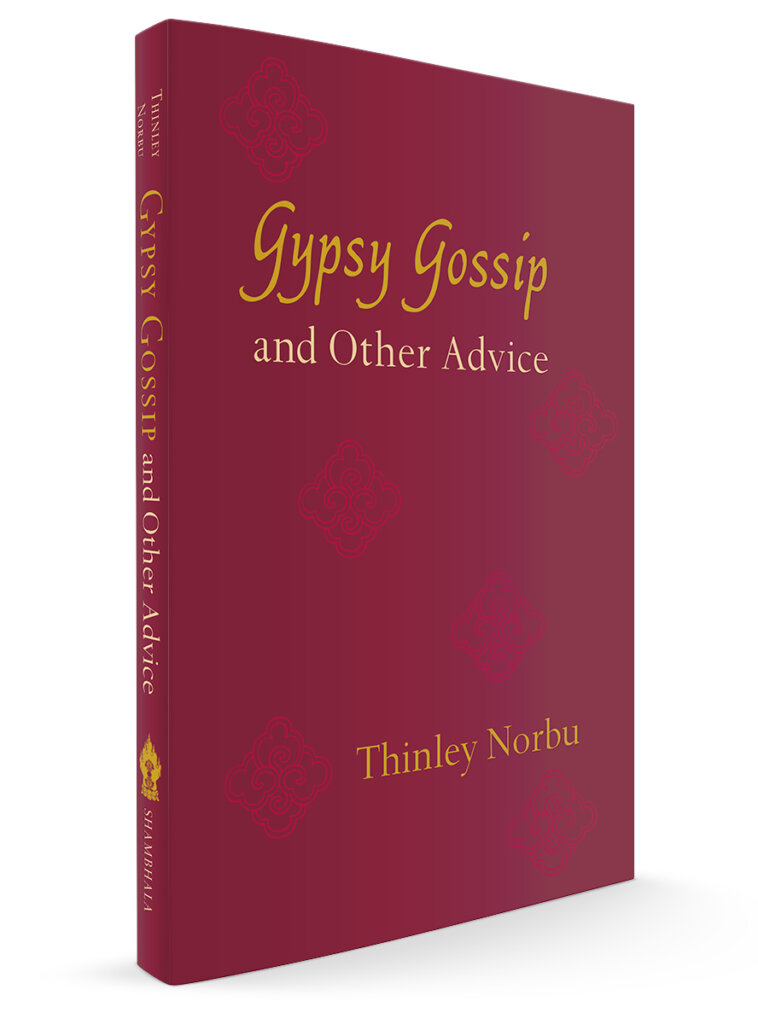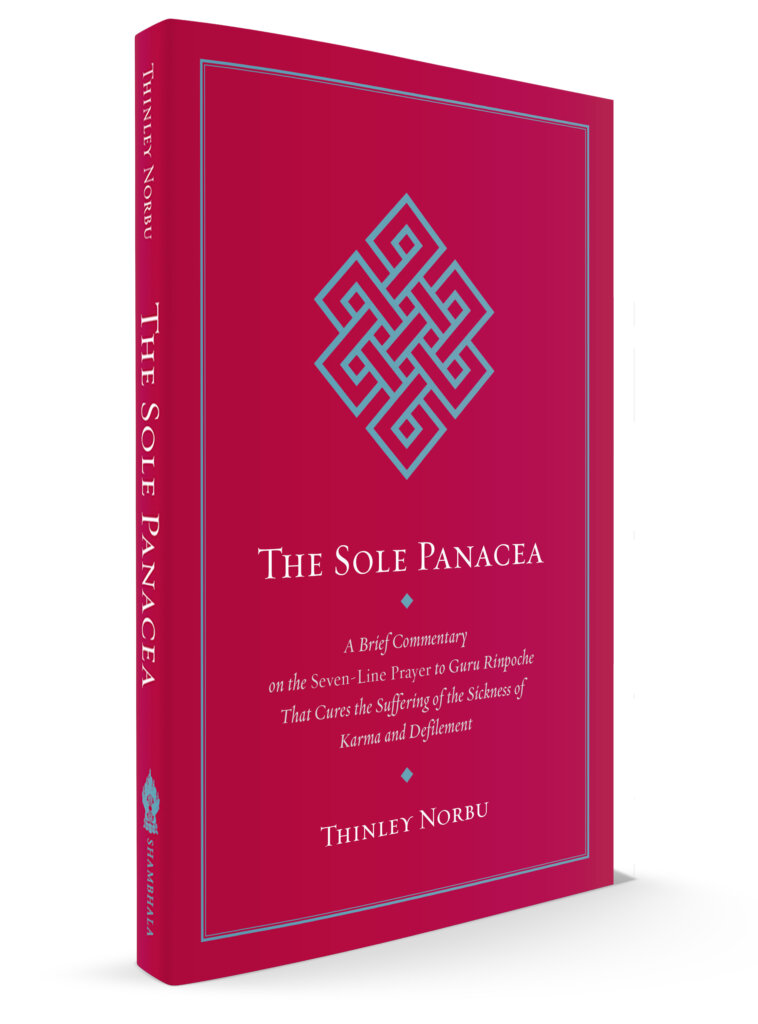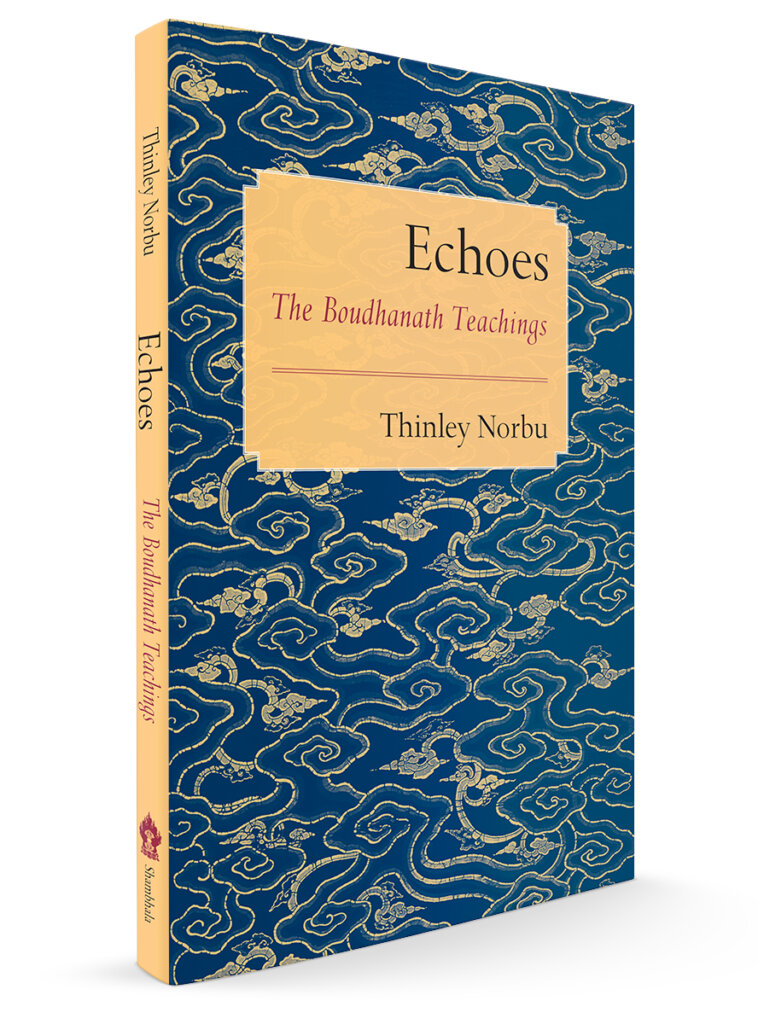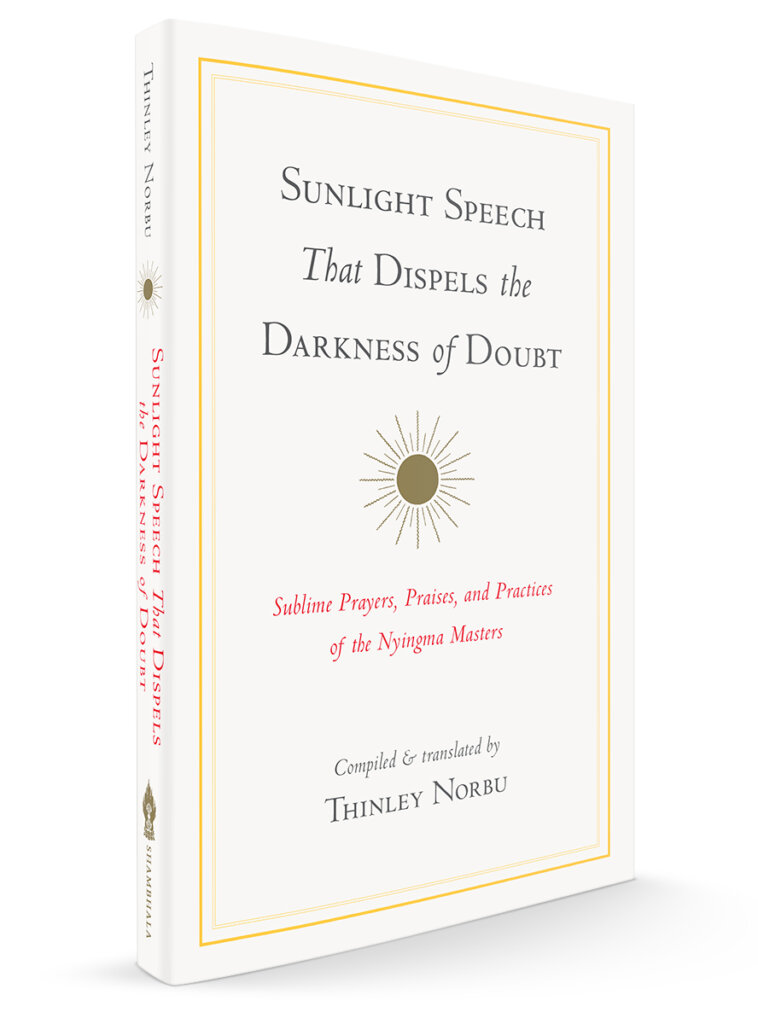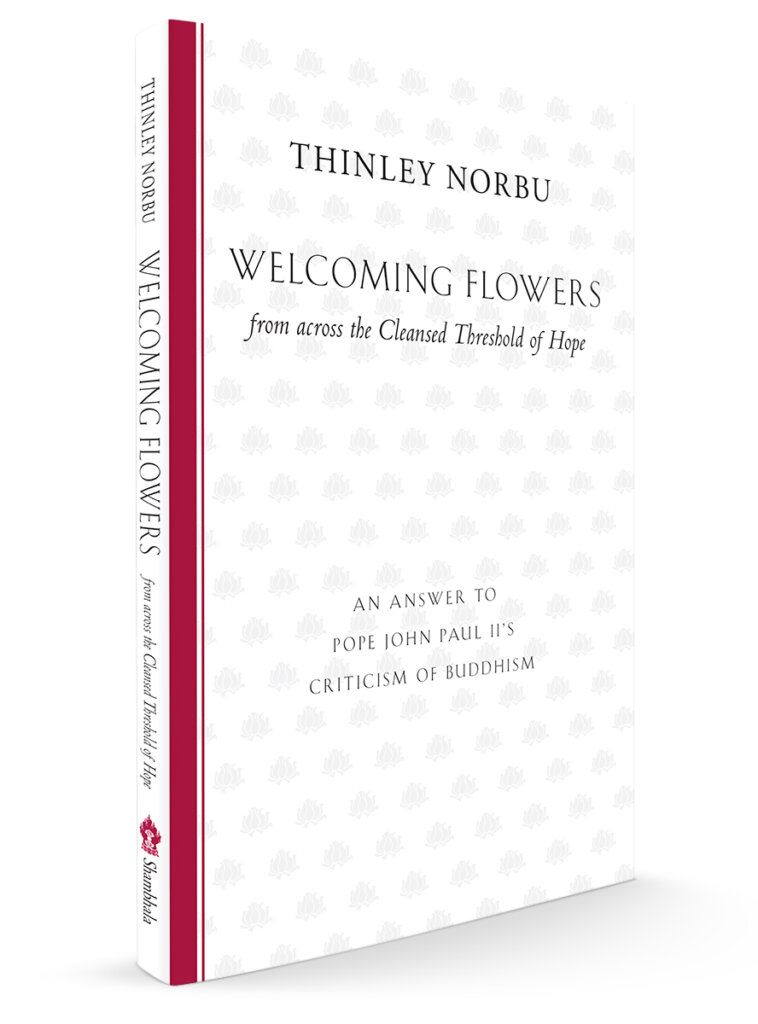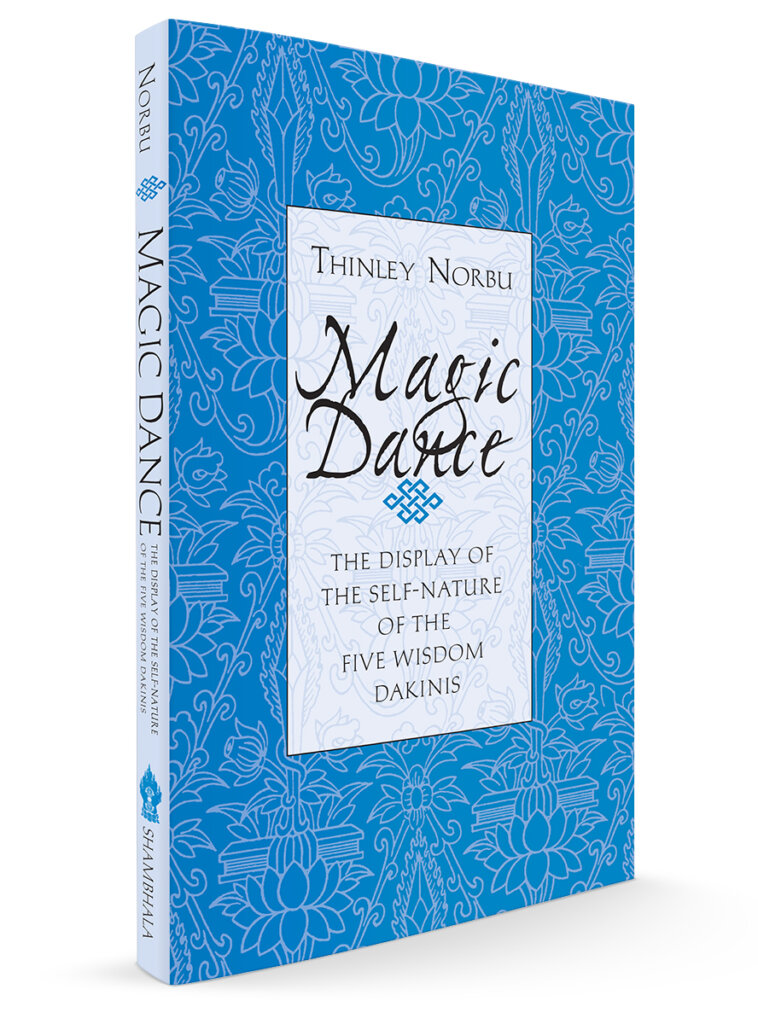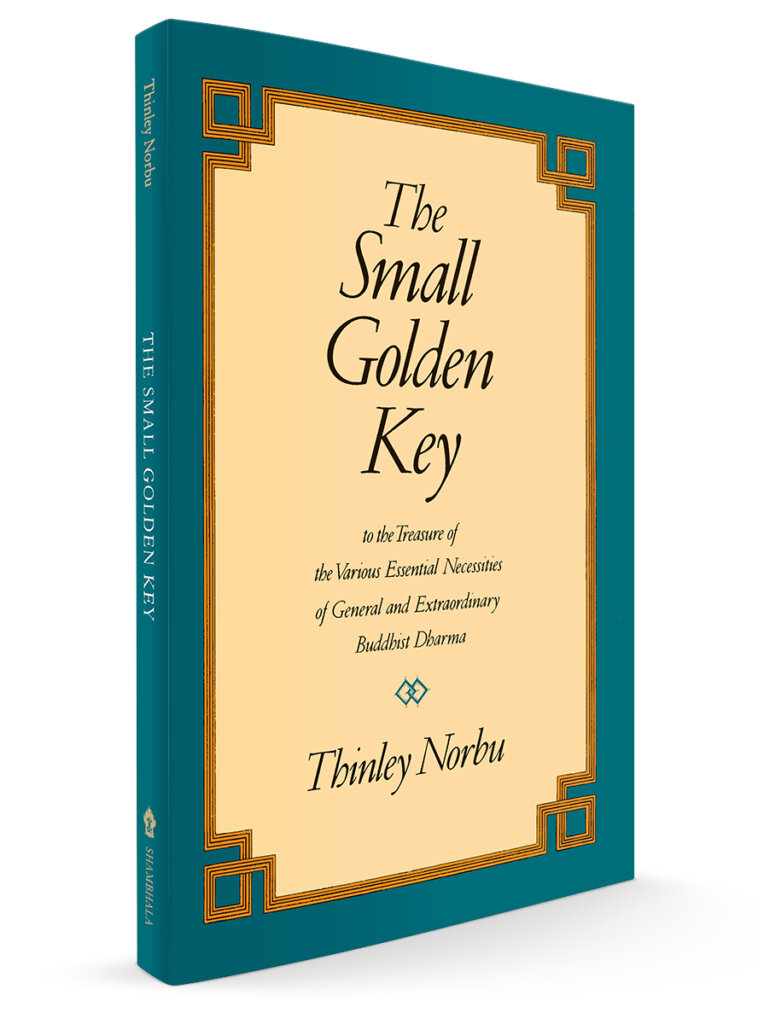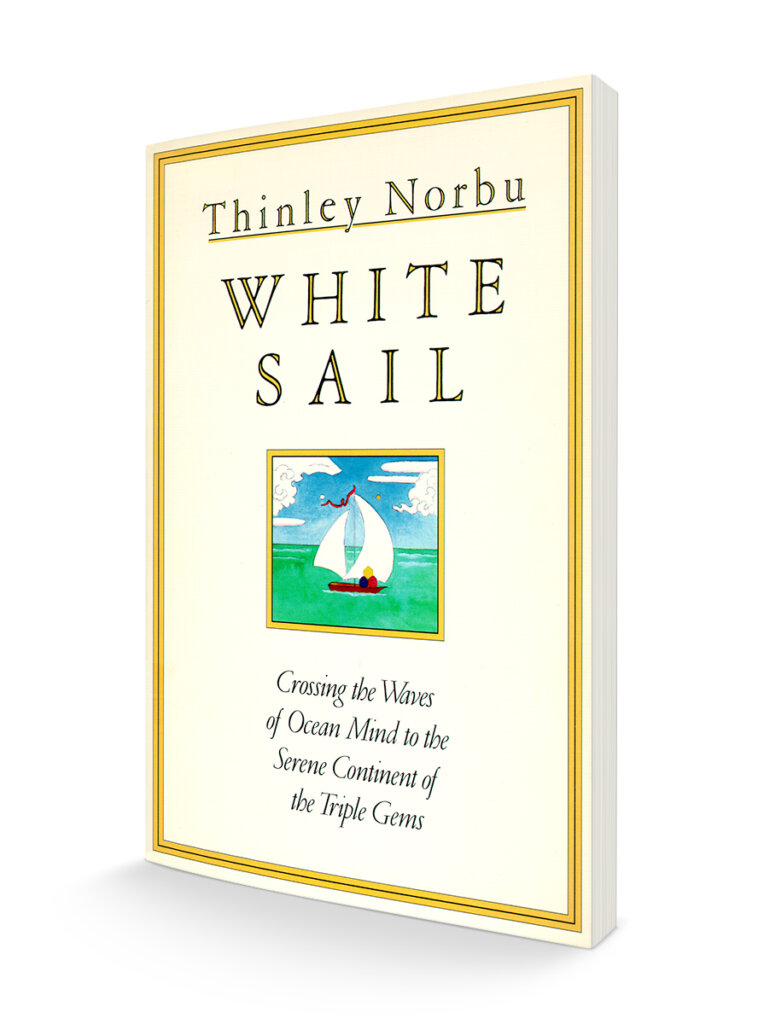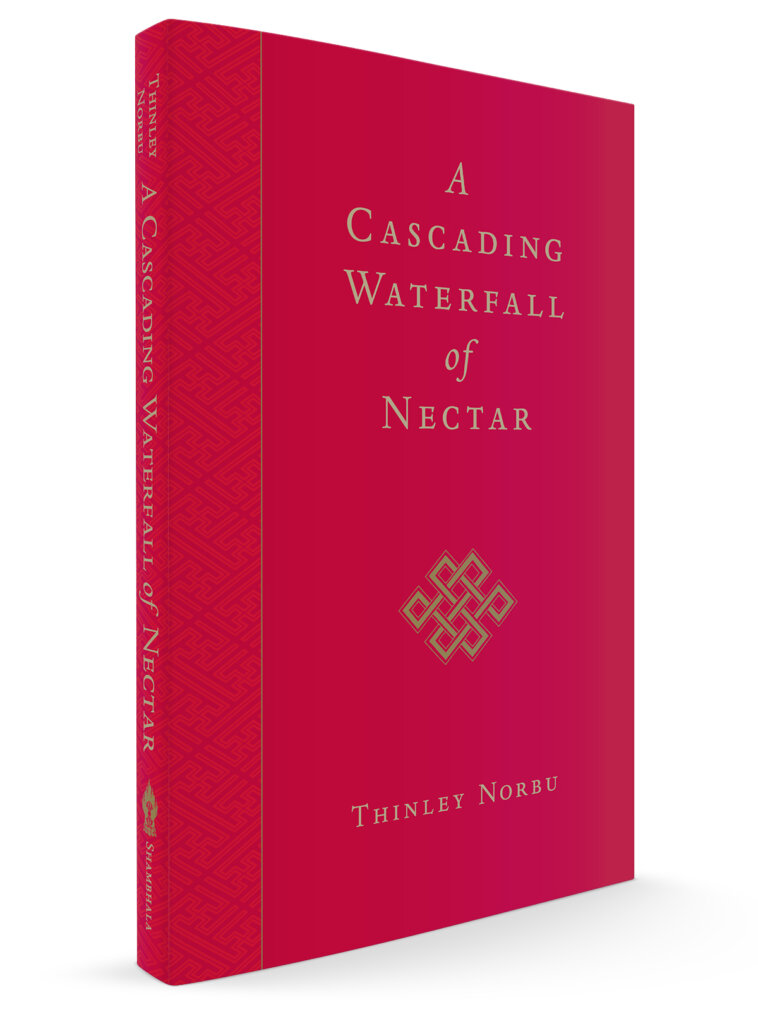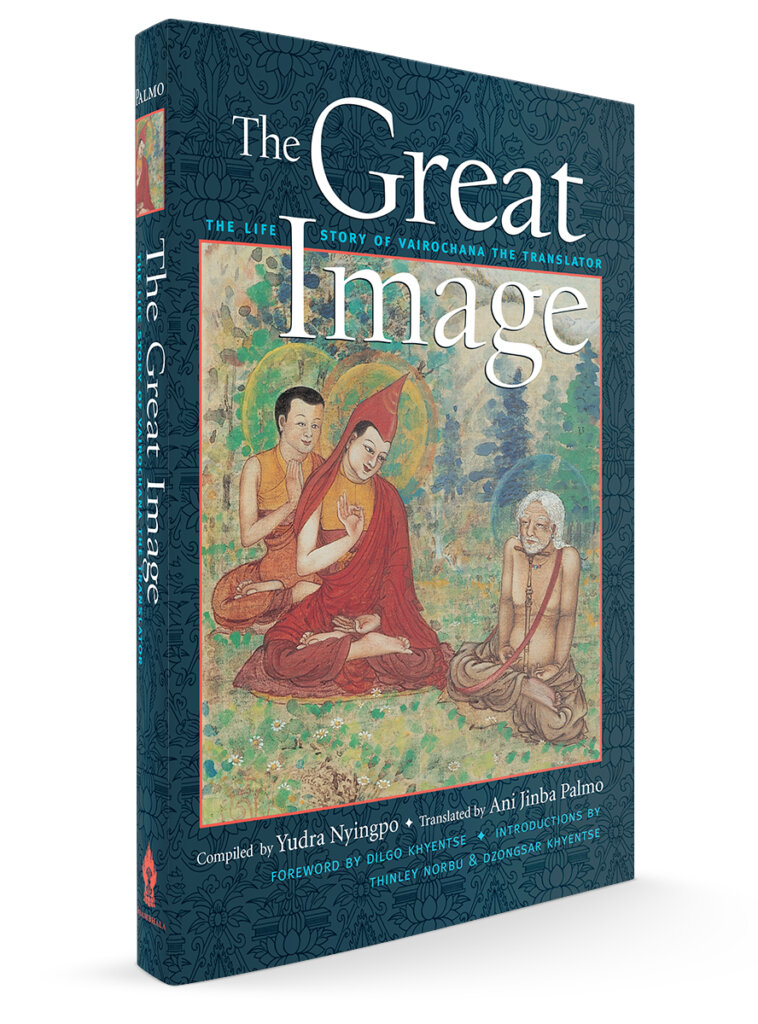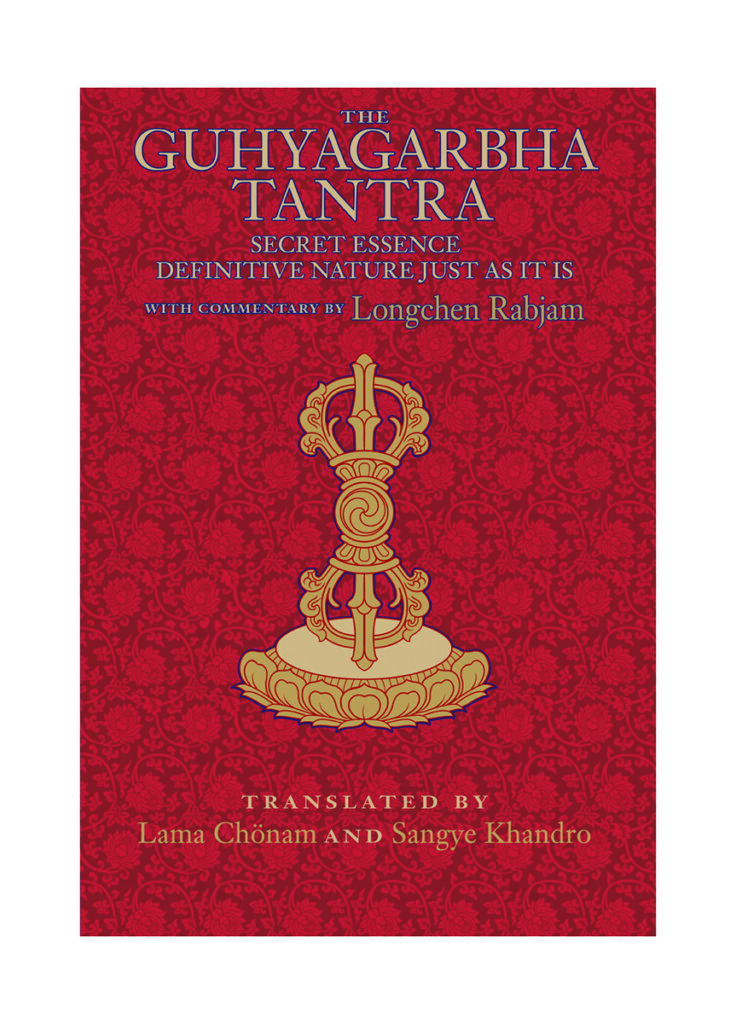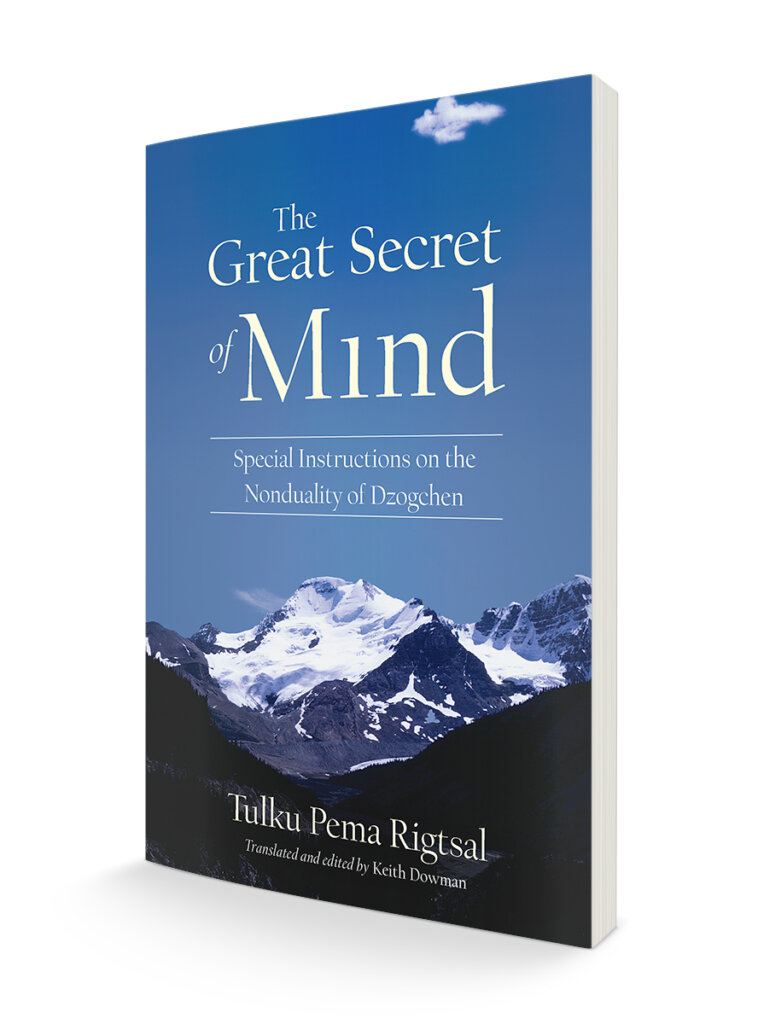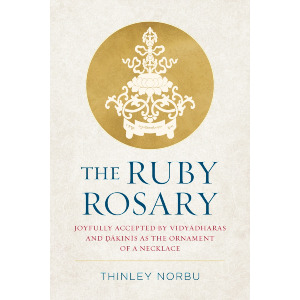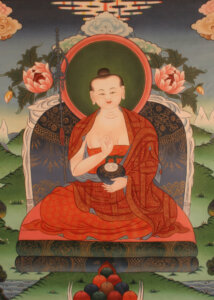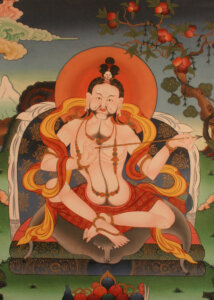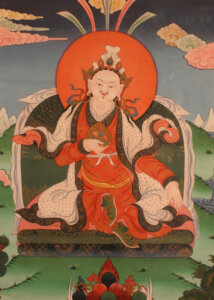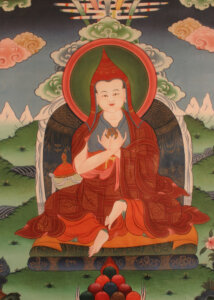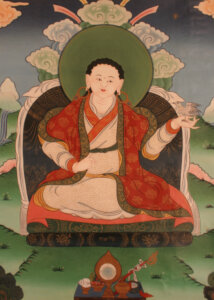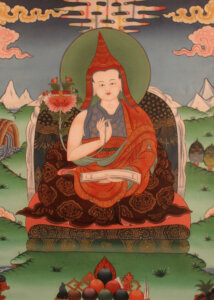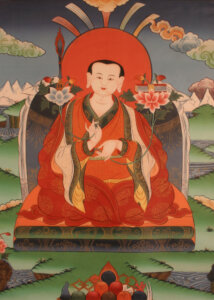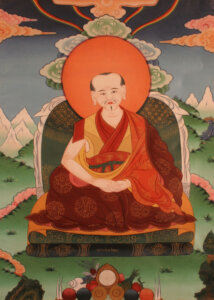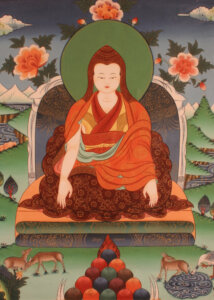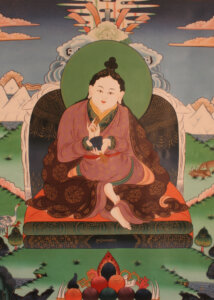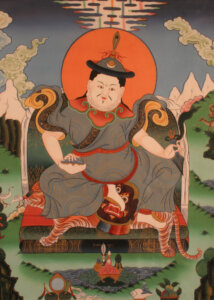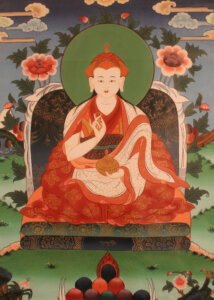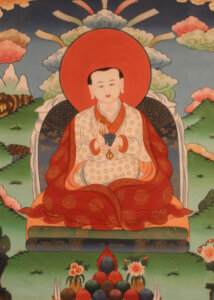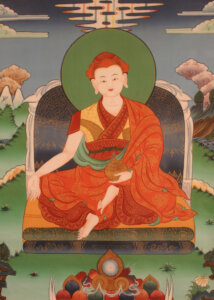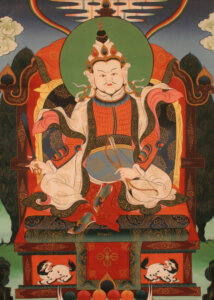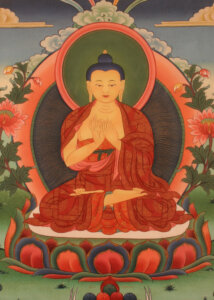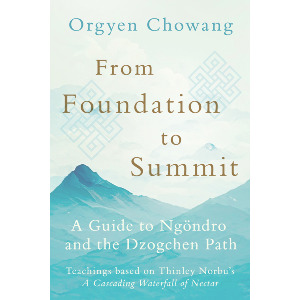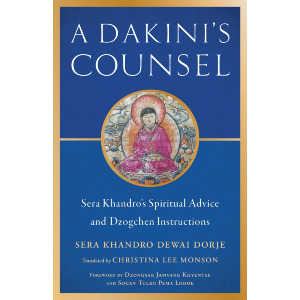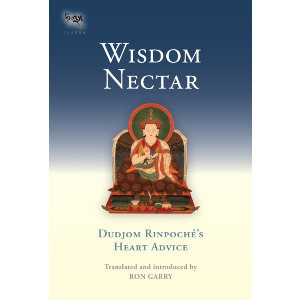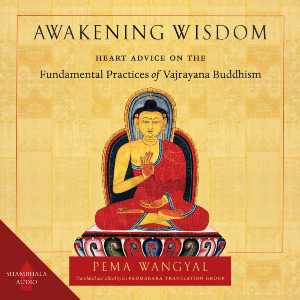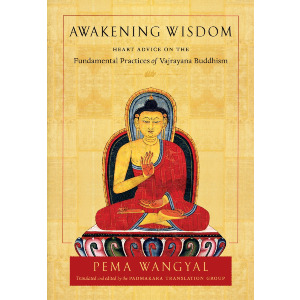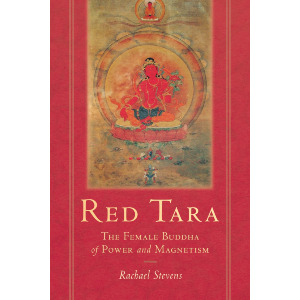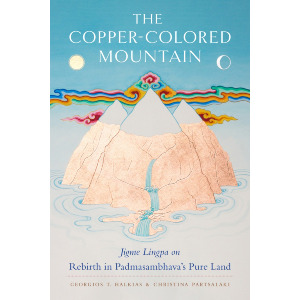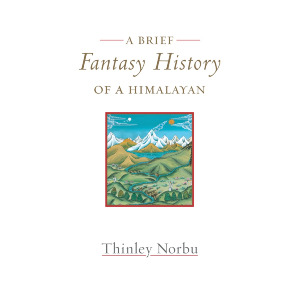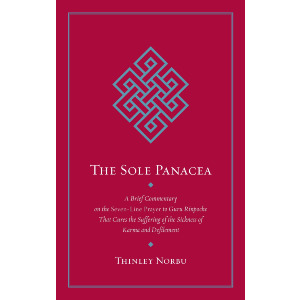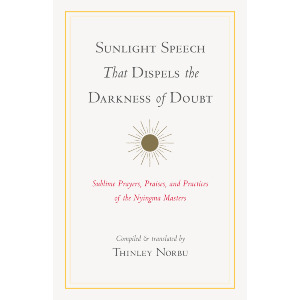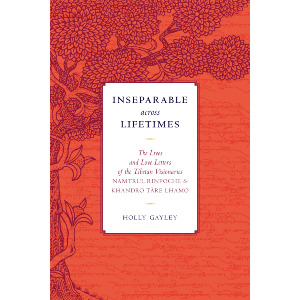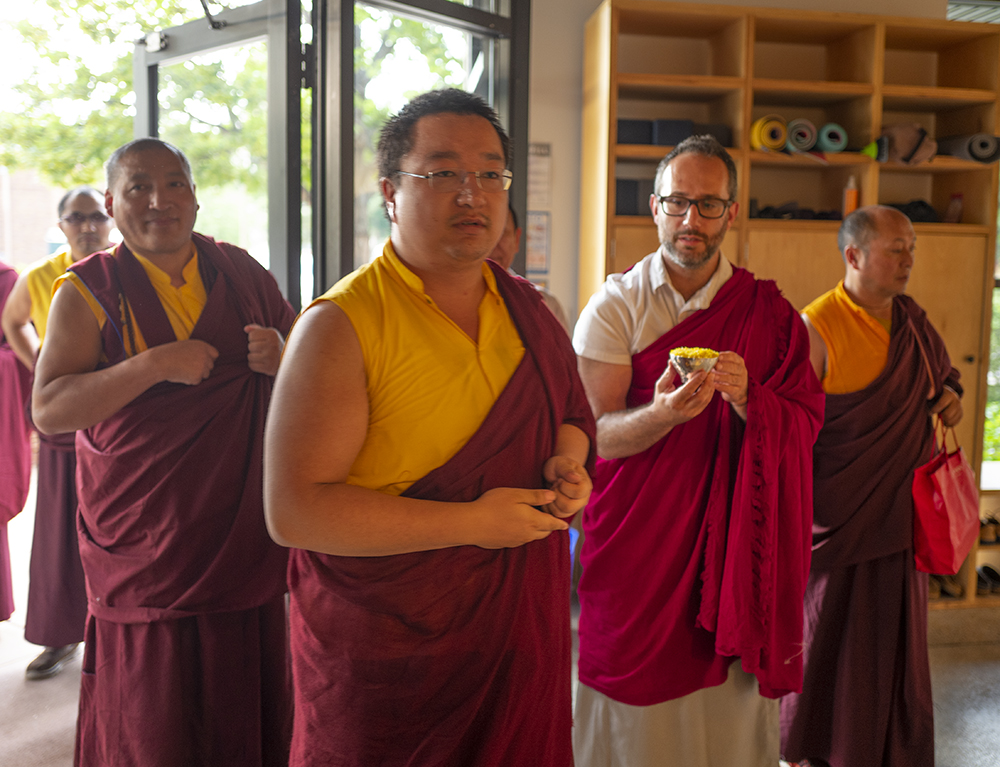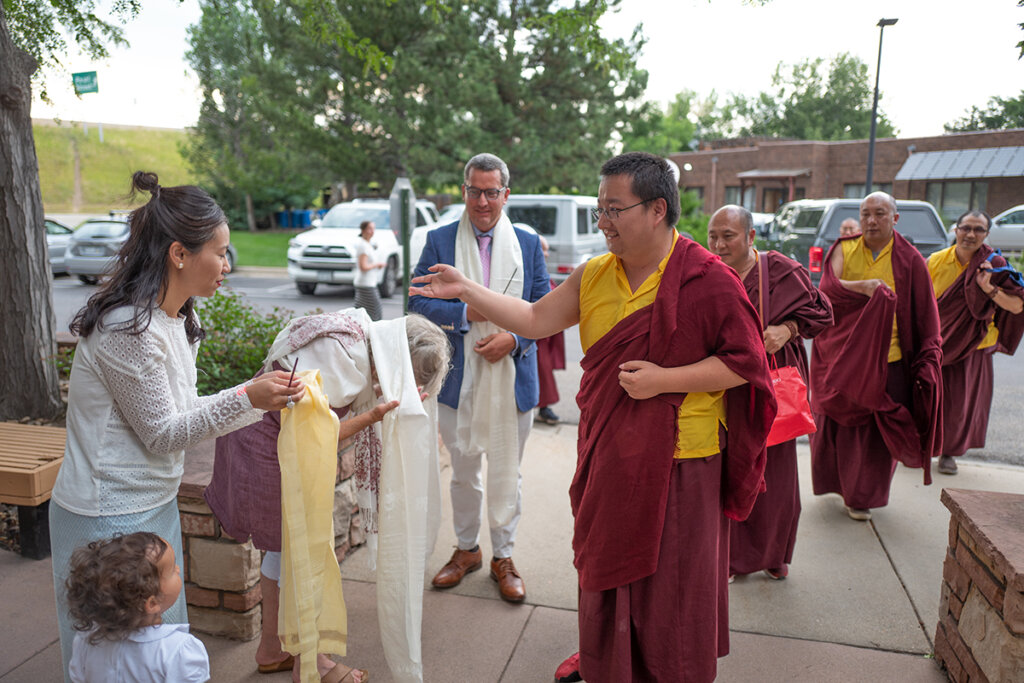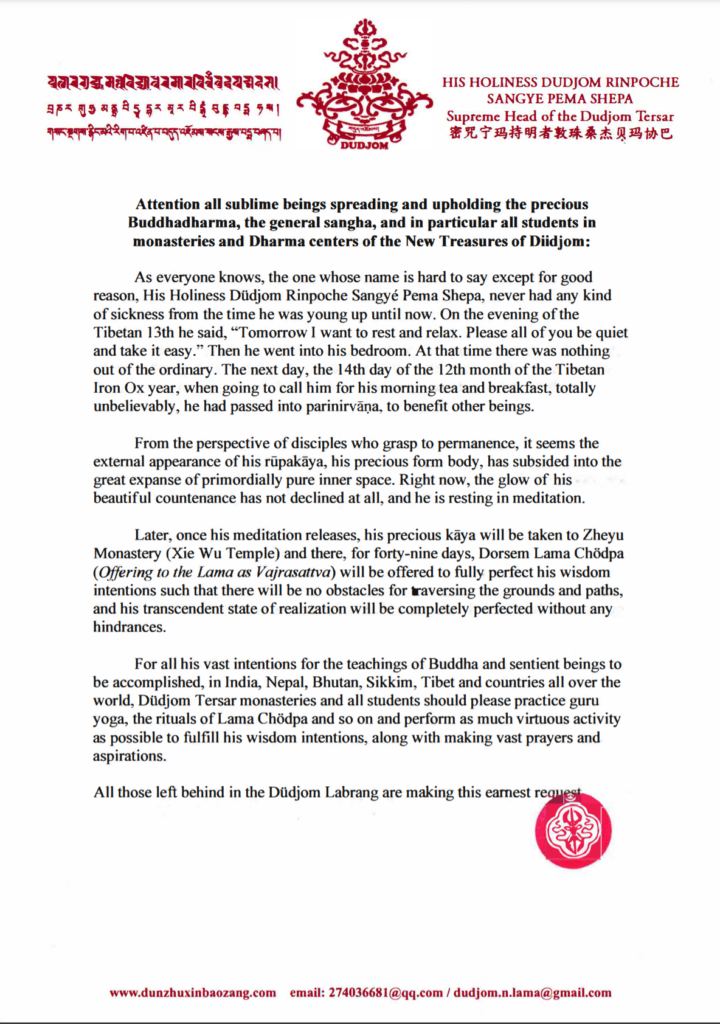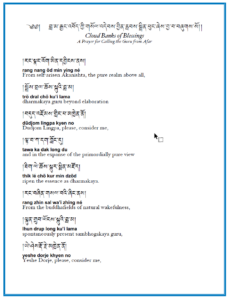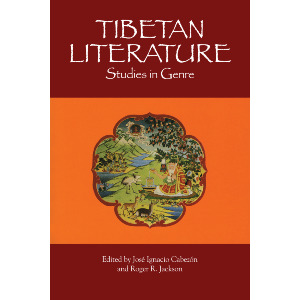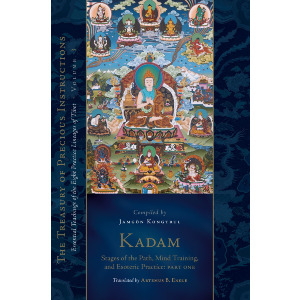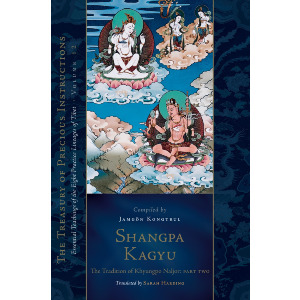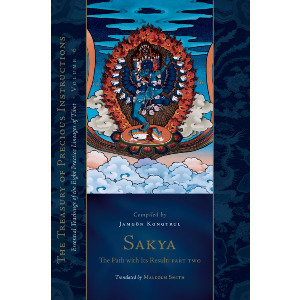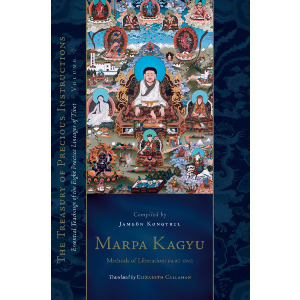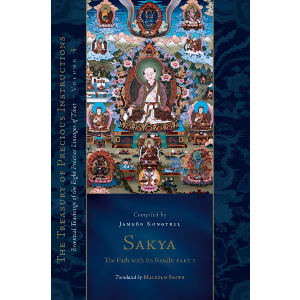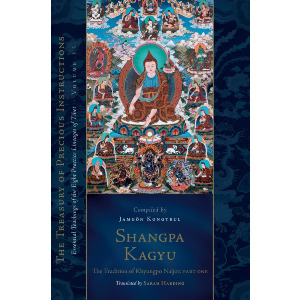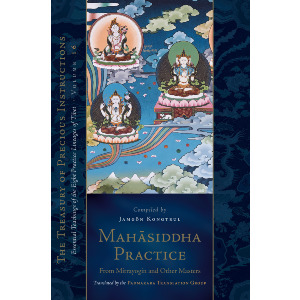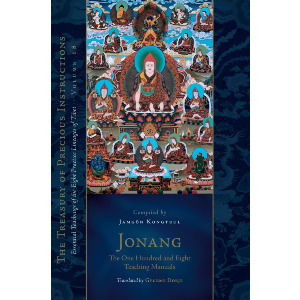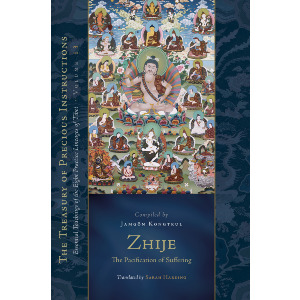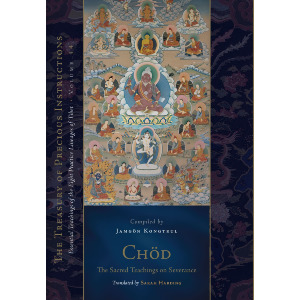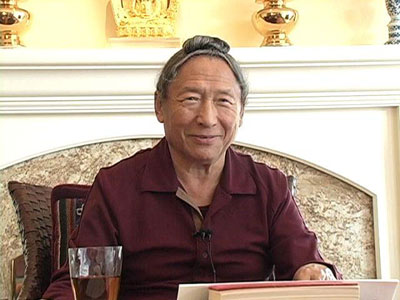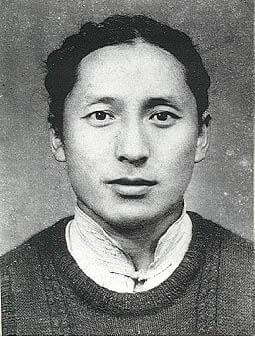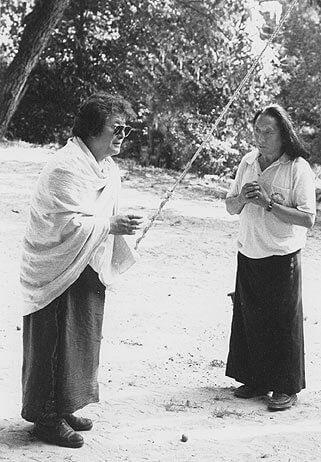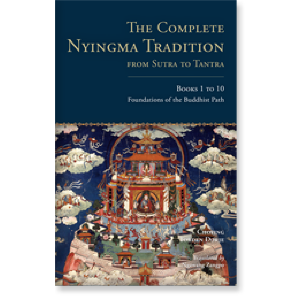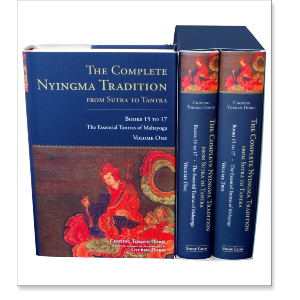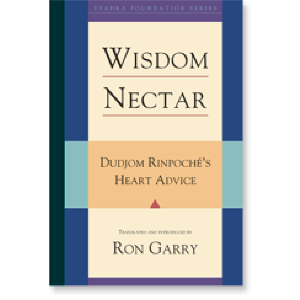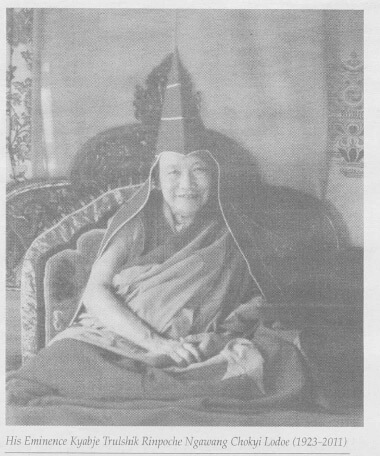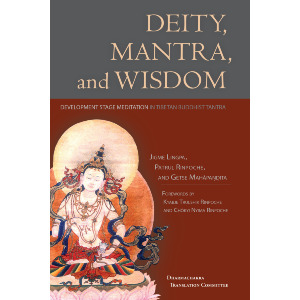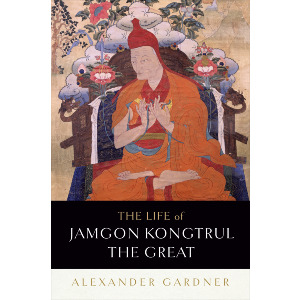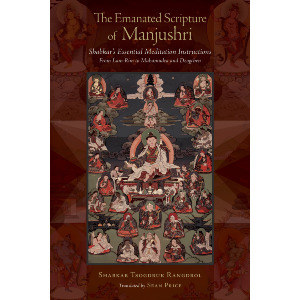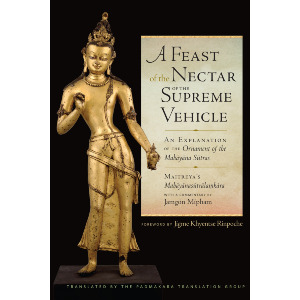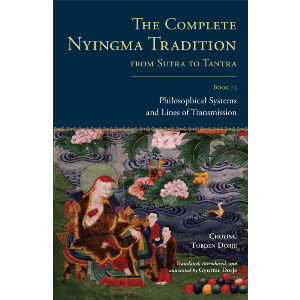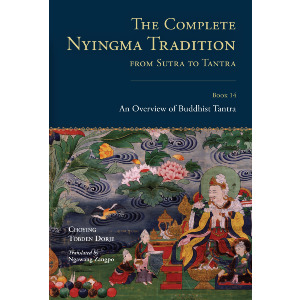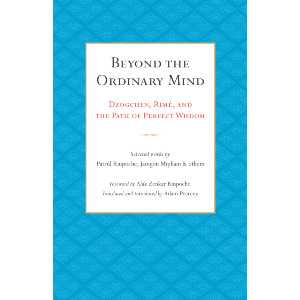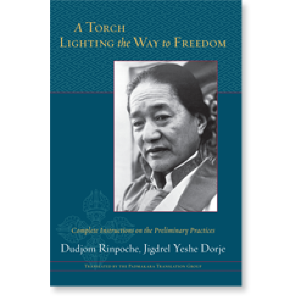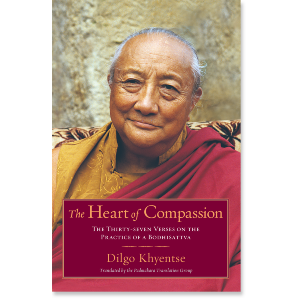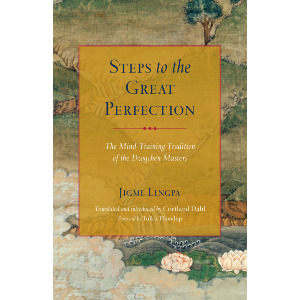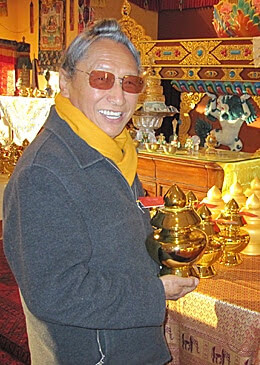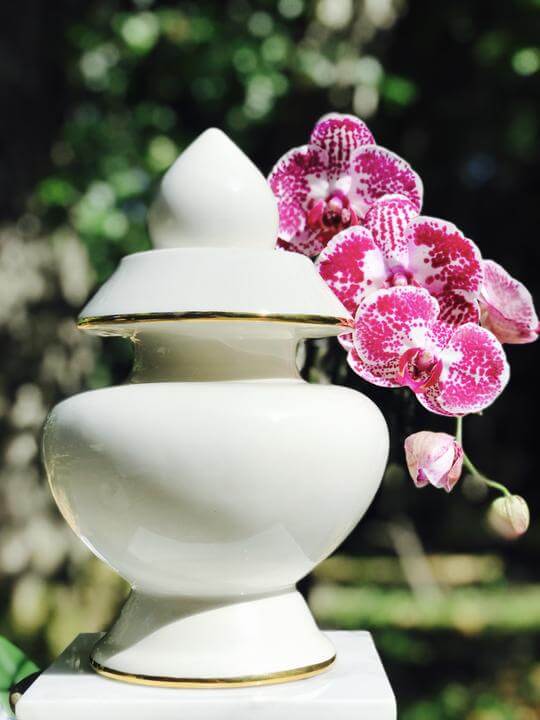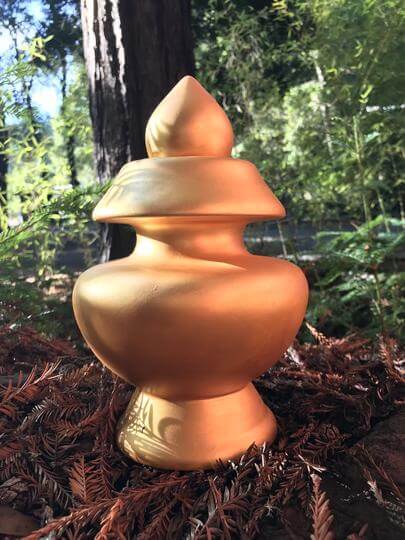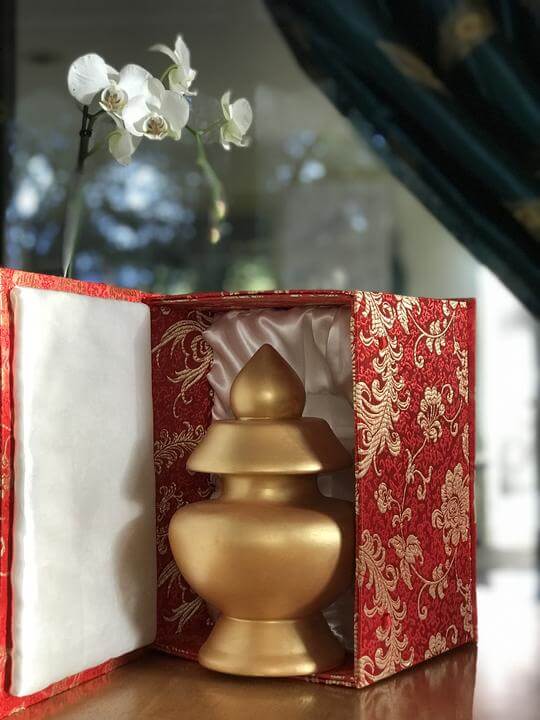Some Nyingma Lineages: Dudjom Tersar | Longchen Nyingtig | Namcho & Palyul
Guides to Other Important Nyingma Figures:
Rongzompa | Longchenpa | Jigme Lingpa | Patrul Rinpoche |
Sera Khandro | Mipham Rinpoche | Dilgo Khyentse | Dudjom Rinpoche
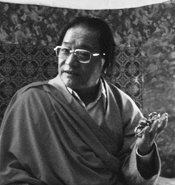

Dudjom Rinpoche
Dudjom Rinpoche, Jigdrel Yeshe Dorje (1904–1987) was a highly revered Buddhist meditation master and the leader of the Nyingma lineage of Tibetan Buddhism. He also traveled and taught extensively, proving instrumental in bringing Buddhism to people in Europe, North America, and other parts of Asia. He founded a teaching and meditation center in Dordogne, France in 1980, where he lived until his death in 1987.
Dudjom Rinpoche
-
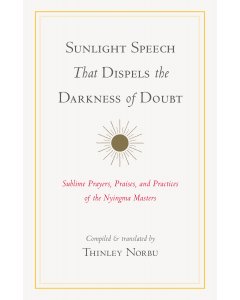 Sunlight Speech That Dispels the Darkness of Doubt$19.95- Paperback
Sunlight Speech That Dispels the Darkness of Doubt$19.95- PaperbackTranslated by Thinley Norbu
By Longchenpa
By Jigme Lingpa
By Jamgon Mipham
By Dudjom Rinpoche
By Patrul Rinpoche -
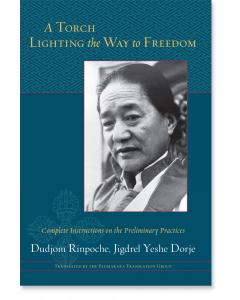 A Torch Lighting the Way to Freedom$34.95- Paperback
A Torch Lighting the Way to Freedom$34.95- PaperbackTranslated by Padmakara Translation Group
By Dudjom Rinpoche -
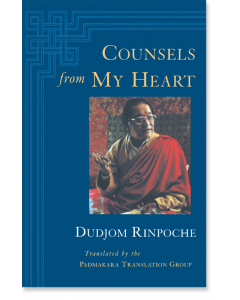 Counsels from My Heart$18.95- Paperback
Counsels from My Heart$18.95- PaperbackBy Dudjom Rinpoche
Translated by Padmakara Translation Group -
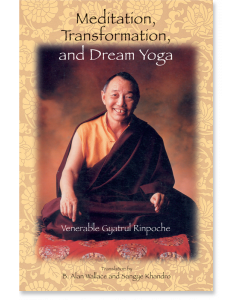 Meditation, Transformation, and Dream Yoga$24.95- Paperback
Meditation, Transformation, and Dream Yoga$24.95- PaperbackBy Gyatrul Rinpoche
Translated by B. Alan Wallace
Translated by Sangye Khandro -
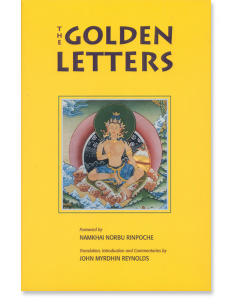 The Golden Letters$39.95- Paperback
The Golden Letters$39.95- PaperbackEdited by John Myrdhin Reynolds
Foreword by Chogyal Namkhai Norbu
Translated by John Myrdhin Reynolds
- Bestsellers Tibetan 1 item
- Buddhist Biography/Memoir 1 item
- Buddhist Ethics 1 item
- Buddhist History 2item
- Buddhist Overviews 2item
- Buddhist Philosophy 1 item
- Bodhisattva Path 1 item
- Bon Tradition 1 item
- Dalai Lamas 1 item
- Dream Yoga 1 item
- Dzogchen 4item
- Guru Yoga 1 item
- Karmapas 1 item
- Ngondro 1 item
- Dudjom Tersar 5item
- Longchen Nyingtik 1 item
- Nyingma Tradition 7item
- Seven Line Prayer 2item
- Tantra 1 item
- Terma / Treasure Texts 1 item
- Biography 1 item
GUIDES
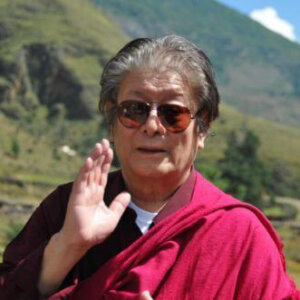
Thinley Norbu Rinpoche: A Guide for Readers

A Guide to His Works
Thinley Norbu Rinpoche (1931-2011) is widely considered one of the most extraordinary Buddhist teachers of the 20th century. His father was Dudjom Rinpoche, Jigdral Yeshe Dorje, and was recognized as an emanation of Longchenpa and reincarnation of Drime Ozer, the son of Dudjom Lingpa. Rinpoche had deep roots in Tibet, Bhutan, and Nepal, where he had many disciples who would come to see him in throngs. Yet like the authentic yogi he was, he eschewed crowds and fame and preferred a life devoted to practice. He lived for decades in the US, settling in upstate New York surrounded by a group of devoted students in a small quiet community, with occasional trips back to Asia. His children include Dzongsar Khyentse Rinpoche and Garab Rinpoche.
The eleven books by Thinley Norbu Rinpoche in English are very difficult to summarize as in almost all cases, their scope, subtlety, and profundity challenge any attempt to quickly describe or categorize. And that is exactly why Rinpoche's books are indispensable and often life changing to those who are open to their incisive observations and expansive view from which they spring.
That being said, what follows is an attempt to capture the flavor of each of these books to give readers a clear idea of where they might like to start.
Latest Releases from Thinley Norbu Rinpoche
Hardcover | Ebook
$39.95 - Hardcover
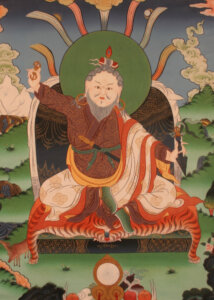
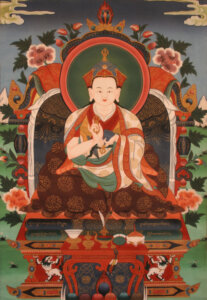
While Thinley Norbu Rinpoche was known as being a yogi and teacher of the Secret Mantra tradition par excellence, his scholarship was second to none. The first half of this work is perhaps one of the clearest presentations of how the teachings of the three yānas of Buddhism came into being, from the previous Buddhas to the coming of Buddha Śākyamuni, to the three councils of the Śrāvakayāna, Bodhisattvayāna, and through the Vajrayāna and Dzogchen.
The Mahayāna receives great detail, with accounts of the lives and importance of figures like Dignāga, Dharmakīrti, Nāgārjuna, Vasubandhu, Āryadeva, Asanga, Vasabandu, Guṇaprabha, Shantideva, Candragomin, Candrakīrti, and more.
The Vajrayāna section gives an account of the tantras of both the Nyingma and Sarma traditions. There is a clear and detailed account of great Tantric figures of India and Tibet as well as the great figures and texts from the Nyingma, Kadam, Sakya, Kagyu, Gelug traditions.
The second half of the book is focused on the Dudjom lineage in particular, whose series of eighteen primary incarnations weaves its way through all the epochs and traditions described in the first half. To list a few:
- Nuden Dorje Chang, the great yogi who lived during the time of the previous Buddha and taught to 1,000 princes destined to become the 1,000 Buddhas of the fortunate eon.
- Śāriputra, the great disciple of the Buddha
- Saraha, the Indian yogi of the Mahāmudrā tradition and teacher of Nāgārjuna
- Krsnadhara, a pivotal figure who served King Indrabhuti and met Padmasambhava as a young boy
- Hūṃkāra, the great master closely associated with the Eight Heruka Sadhanas
- Drogben Khyeuchung Lotsawa, one of Padamasambhava’s main disciples and a great translator
- Smṛtijñāna, the Indian pandita who was a student of Naropa
- Rongzom Chökyi Zangpo, the master ands scholar whose importance in the Nyingma tradition cannot be exaggerated
- Katok Dampa Deshek, the brother of Phakmodrukpa and holder of many traditions, who founded Katok monastery
- Lingje Repa, the great yogi of the Drukpa Kagyu tradition
- Drogön Chögyal Phagpa, one of the great figures of the Sakya school
- Dudjom Lingpa
- Dudjom Rinpoche Jigdral Yeshe Dorje
Thinley Norbu Rinpoche uses as a basis for the explanation of these figures the text entitled “The Pearl Necklace,” a prayer of devotion to these masters of the Dudjom incarnation lineage, “strung together into a necklace of liberated lifetimes.” With lively storytelling, Rinpoche illuminates the life of each of these great masters including a detailed account of the enlightened activities of Dudjom Rinpoche himself, as well as two more figures prophesized to follow, Dorje Nönpo and Möpa Thaye (Buddha Adhimukta).
The work has a foreword by the late Dudjom Yangsi Rinpoche who left us far too soon in 2022, as well as a foreword by the great Alak Zenkar Rinpoche. The lengthy introduction was authored by Lama Tharchin Rinpoche, whose devotion to Thinley Norbu Rinpoche was a model for all practitioners.
A Brief Fantasy History of a Himalayan: Autobiographical Reflections
Rinpoche wrote these words about this autobiographical work:
"I wrote Brief Fantasy History of a Himalayan in the countryside of New York in the springtime amid swaying weeping willow trees because some of my loving American friends requested me to tell my life history. They helped me through their fanatical, positive hallucination phenomena toward me and my speech which is like brass, but which they saw like pure gold and tried to make as an ornament for the Buddha's teaching."
This stands as an incredible document of a life of a mahasiddha, tracking his early life with his father Dudjom Rinpoche, and many other great masters in Tibet, Nepal, Bhutan, and the US. But this book is also brimming with profound wisdom and advice readers. Here is a sample passage:
Modern students behave very differently from ancient students of Dharma, if I judge from their histories. They are like children in a toy store who want to play with all the toys at once. Grasping, they go from one toy to another, capriciously throwing each one away when they have become tired of it or have difficulty making it work. Through changing intentions and strong divorce habit, they abandon their playthings with many different excuses. When they say, “my former teacher,” this means their abandoned teacher, and since all teachers are embodiments of the same Buddha essence, this means that they have abandoned the Triple Gems and the path of enlightenment.
Their Dharma is like their television: they are momentarily entertained, but when they are bored with one program, they constantly channel-change until they once again become bored. Just as they leave their worldly teachers when they find out what they want to know from them, they may leave their Buddhist teachers, even though they vowed when they took refuge in the words of the Buddha that they would never abandon the Buddha, never abandon the Dharma, never abandon the Sangha, and never abandon their teacher until they reach enlightenment. According to Buddhist tradition, the teacher is the representative of the Buddha, yet they think they can divorce tradition.
Even if they like to practice, they aren’t patient enough to digest their experience because of their fast-food habit. Through digestion, they could increase many qualities, but they just want to taste superficially and don’t care about essential nourishment. Instead of letting experiences come patiently and naturally, they want results to appear instantly, the same way that apples are artificially waxed and oranges are dyed for an instant ripe appearance.
Besides these people, there are a few Dharma practitioners suffering from their work, their marriages, or their lovers, who are temporarily weary of samsara and just want to feel good, but they don’t want to practice, because they only want to be comforted and to feel better. As a saint once said, those who ring the bell and hold the dorje without knowing what the true meaning is are no different from a cow that makes noise as it grazes with a bell around its neck.
Finally, there are very few truly serious Dharma practitioners. Though worldly people are not pleased to see Dharma practiced in a pure way, certainly the Buddhas and Bodhisattvas are smiling. Confidence does not come from having either one or many teachers. It depends on the individual’s karmic faculties. Ancient Dharma students could synthesize the teachings of many different teachers into one pure lineage wisdom essence. Each teacher had different qualities and expressed different aspects of wisdom mind. They respected each beautiful form without the conception of abandoning previous forms, like noble bees who can sip the same sweet essence nectar from different flowers—some red, some blue, some white—without harming them.
Paperback | eBook
$22.95 - Paperback
Gypsy Gossip and Other Advice
Rinpoche wrote of the main part of this work:
"I wrote Gypsy Gossip because there was so much paranoia between the negative and positive fashions of current spiritual ideas and between the different religious habits of nihilists and spiritualists".
The first selection, the eponymous “Gypsy Gossip,” was originally printed in 1980 as a small book in a very limited private edition. In its present edition it is happily now available to a wider audience. In an informal atmosphere of spiritual openness, Kyabje Thinley Norbu Rinpoche answers questions from Western students about Tibetan Buddhism, including the teachings of karma and rebirth, monastic discipline, devotion to the Guru, and the importance of keeping vows.
“Beyond East and West” consists of Rinpoche’s written replies to questions submitted in writing by Melvin McLeod, editor-in-chief of Buddhadharma and Shambhala Sun magazines, during a visit to Rinpoche’s residence in Delhi, New York, around 1999. In this interview, published here for the first time, Rinpoche gives an extensive commentary on how cultural differences have affected the adoption of Tibetan Buddhism in the West, and emphasizes that Westerners’ Buddha nature can be rekindled through a greater development of faith and belief.
“A Message for Young Bhutanese” was written for an organization called the Young Buddhist Association of Bhutan. Rinpoche had a close personal connection with the kingdom of Bhutan. In this message Rinpoche urges Bhutanese youth to preserve their spiritual heritage (including study of the Tibetan language) and to carry its blessings onward amid the modern influences of materialism. Rinpoche warns against introducing foreign nihilistic beliefs into Bhutan and creating sectarian conflicts between its indigenous lineages.
“An Introduction to Dharma Dance Offerings” was written in connection with several teaching films directed by Kyabje Thinley Norbu Rinpoche, who was an accomplished practitioner and teacher of sacred dance. Rinpoche contrasts ordinary dancing, which expresses the passions of material reality and lacks the positive influence of wisdom, with the Dharma dances of Tibet, which manifest the enlightened activities of peaceful and wrathful deities.
Paperback | eBook
$19.95 - Paperback
The Sole Panacea: A Brief Commentary on the Seven-Line Prayer to Guru Rinpoche That Cures the Suffering of the Sickness of Karma and Defilement
The Sole Panacea is a slim volume on the Seven Line Prayer to Guru Rinpoche, one of the most important and profound prayers which holds multiple layers of increasingly subtle meaning. However, it covers a lot more. The first half of the book includes teachings on:
- The beliefs of various doctrines of eternalism and nihilism, which depend on the temporary circumstances of the agreement or disagreement of phenomena and objects of phenomena.
- The reason that wanting to understand the immaterial, absolute nature of mind with the help of material scientific technology is building a castle of sand, which can never be reliable; and how important it is to actually believe in the three supports of worship and holy places, mountains, and caves.
- Dispelling the doubts that have circulated discriminating between Padma Jungne who came to Tibet and Padmasambhava.
- A debunking of the claim that Jatsön Nyingpo is the only fully ordained tertön, and how this contradicts both Buddha’s speech and logic.
- The views of the various doctrines of Buddhism
- The various ways of recognizing the Triple Gems, the object of refuge, in the common and uncommon vehicles
- The way that Hīnayāna does not accept Mahāyāna, and the Mahāyāna reply that clears this contradiction.
- A summary of the various beliefs of the higher and lower vehicles.
- The definition of "Chomdendé" and the histories of peaceful and wrathful deities.
With that as a substantial prelude, the Seven Line Prayer comes into sharp focus. First is a historical account of the origin of the Seven-Line Prayer and the greatness of its blessings. The pure mindfulness of practicing the outer meaning of the Seven-Line Prayer. And fnally explaining how to approach practicing the inner meaning of the Prayer.
Paperback | eBook
$18.95 - Paperback
Echoes: The Boudanath Teachings
Of this short but penetrating work, Rinpoche wrote,
"Echoes contains what I taught in Boudhanath with many international Dharma yogis and yoginis, using the traditional method of question and answer to connect ordinary experience with sublime Dharma in a flexible way.""
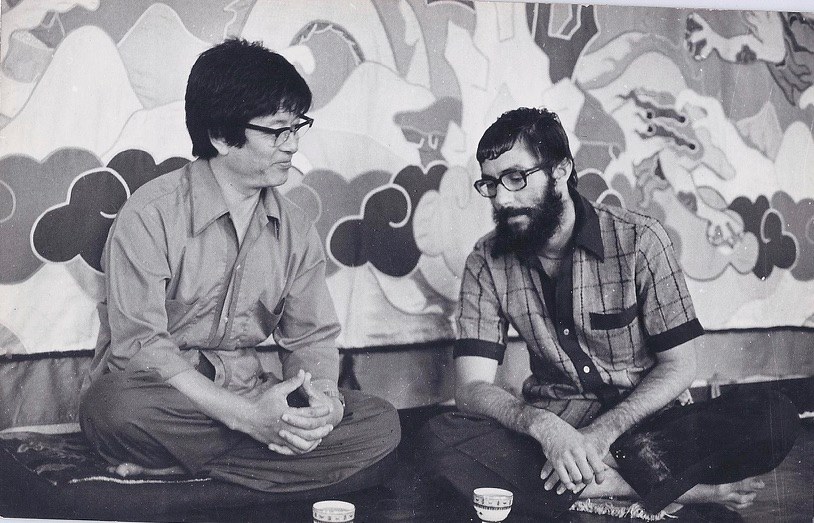
Thinley Norbu Rinpoche giving the teachings that formed Echoes. Photos courtesy of the translator, Shakya Dorje, shown here.
In colorful, bustling Boudhanath—Buddhism's great pilgrimage site in Nepal—a small group of students gathered to speak with Kyabje Thinley Norbu Rinpoche in an informal, relaxed atmosphere. This is the record of their lively dialogue. The contents cover a wide range of inquiry: How should Westerners understand the Tibetan Buddhist teachings on karma and rebirth, monastic discipline, the importance of keeping vows, and devotion to the Guru? What is the Buddhist stand on male supremacy? Must Vajrayana practitioners have a consort? What is the antidote to self-hatred? How do we put into practice the “same taste” of suffering and pleasure? Echoes is part of the cherished legacy of one of the greatest realized Nyingma masters of our age. Here is a sample passage:
The greatest enemy of Dharma is doubt. When we set out to practice Dharma, we must develop the determination to follow through with it, to persevere in the development of realization. In Tibetan Buddhism there are many symbolic portrayals of male and female figures in union, and many Tibetans who practice Dharma feel that these symbolic expressions are just something to meditate on, with no indication as to any further practice. These people make judgments and decisions. But Dharma is not just symbols; it’s also something significant and real that we have to practice. If we are going to practice in any real sense, we should avoid doubts and not worry about anyone else’s opinion. We should just practice straightforwardly to attain realization. In the symbolism of male-female union, the deities are not joined in mundane desire but as a means to control and destroy the defilement of desire. It is their desire itself that achieves this, a desire beyond the realm of ordinary desire. This is not the union of ordinary beings. The female figure represents essential emptiness, and the male figure represents phenomenal expression. Their union represents the inseparability of phenomenal expression and essential emptiness. All the symbolism of the various deities is a means of training and subduing the defilements—they are in fact antidotes.
Paperback | Ebook
$19.95 - Paperback
Sunlight Speech That Dispels the Darkness of Doubt: Sublime Prayers, Praises, and Practices of the Nyingma Masters
By Longchenpa, Jigme Lingpa, Jamgon Mipham, Dudjom Rinpoche, and Patrul Rinpoche
In this sublime revision, Kyabje Thinley Norbu Rinpoche has translated a selection of wisdom teachings into direct and simple English that retains the power of the original writings and their emphasis on practice. The authors are five of the most sublime scholar-saints of the Nyingma lineage of Tibetan Buddhism: Kunkhyen Longchenpa, Kunkhyen Jigme Lingpa, Patrul Rinpoche, Mipham Rinpoche, and Kyabje Dudjom Rinpoche. Their compositions include words of advice, poetic praises, concise daily prayers, and liturgies accompanied by instructions. Written over a span of time from the medieval to the modern era, these precious teachings are intended to be the cornerstones of faith, practice, and enlightenment.
Praises
- Praise to Longchenpa
- Praise to Jigme Lingpa
- Praise to Manjushri by Mipham Rinpoche
- Praise to the Melodious Wisdom Goddess Saraswati Called “The Melody of the Youthful Display of Joy” by Kunkhyen Longchenpa
- Praise to Patrul Rinpoche by Jamyang Khyentse Wangpo
- Praise to Mipham Rinpoche
- Praise to Dudjom Lingpa by Kyabje Dudjom Rinpoche
Teachings and Sadhanas
- The Practice of the View, Meditation, and Action, Called “The Sublime Heart Jewel”: The Speech Virtuous in the Beginning, Middle, and End by Patrul Rinpoche
- Mindfulness, the Ocean of Qualities by Rigdzin Jigme Lingpa
- The Lion’s Roar: Cutting Through the Errors and Deviations of the One Free from Activity, Meditating on the Heart Essence by Rigdzin Jigme Lingpa
- Always Rejoicing in the Forest by Kunkhyen Longchenpa
- Praise of the Ten Deeds of Buddha by Rigdzin Jigme Lingpa
- The Treasure of Blessings of the Ritual of Buddha by Mipham Rinpoche
- The Sadhana of Fully Enlightened Supreme Vajrasattva, Called “The Daily Practice of the Profound Path, Contained in Essence” by Kyabje Dudjom Rinpoche
- The Rain of Blessings: Guru Yoga in Connection with the Seven-Line Prayer by Mipham Rinpoche
- The Assembly Palace of Great Flawless Exaltation,Radiant Lotus Light by Kyabje Dudjom Rinpoche
- Calling the Lama by Kyabje Dudjom Rinpoche
- The Guru Yoga of Receiving Wish-Fulfilling Great Flawless Exaltation by Kyabje Dudjom Rinpoche
Paperback | eBook
$19.95 - Paperback
Welcoming Flowers from across the Cleansed Threshold of Hope: An Answer to Pope John Paul II's Criticism of Buddhism
Welcoming Flowers is a pointed critique of the Buddhism chapter of Pope John Paul II’s 1994 best seller, Crossing the Threshold of Hope, written at the request of some Polish students. In responding to the false charges of Buddhists’ indifference to the world and rejection of reality, Rinpoche clarifies the Buddhist doctrines of detachment and enlightenment. In addition, he covers the topics of good and evil, human nature, karma, cosmology, and dualistic mind, bringing them into conversation with the Christian perspective as presented by the Pope. The intention is not to shoot back arrows in an attack on Catholicism but to spread “welcoming flowers”—that is, to present the exalted teachings of the Buddha in all their loveliness. In this sense, the book serves as a helpful introduction to the Buddhist worldview.
Paperback | eBook
$19.95 - Paperback
Magic Dance: The Display of the Self-Nature of the Five Wisdom Dakinis
Of this singular work, Rinpoche wrote,
"Through the circumstance of a good friend's desire to know about how the elements work within beings, I wrote Magic Dance: The Display of the Self-Nature of the Five Wisdom Dakinis in New York and Paris, very naturally, without putting in many different traditional category systems or ideas".
Here is an excerpt:
Even without meditating or using any Dharma conceptions, spiritual qualities exist from the beginning. Spiritual energy is like a young natural forest, which can be burned away through frustrated anger. Like fire, when frustrated anger becomes heavier and heavier, light spiritual energy diminishes like smoke. After the fire, both gross element energy and subtle element energy are exhausted and only the gray ashes of empty sadness remain. Then, lacking support from worldly gross elements and from inner subtle elements, our mind becomes weak and sorrowful.
But through play, spiritual energy can be sustained, so we must not think that play is always bad. Whether or not our rigid mature minds reject play, everything is still the display of the natural secret essence of the elements. If we are serious and rigid, our subtle elements become congested and cannot reflect this wisdom display.
If our mind is calm and vast and playful, we can always recognize this essence display. In open space, there is never turbulence between the gross and subtle elements.
Paperback | eBook
$19.95 - Paperback
The Small Golden Key: To the Treasure of the Various Essential Necessities of General and Extraordinary Buddhist Dharma
On this short book, Rinpoche wrote, "The Small Golden Key , which I wrote in Honolulu, is predominantly very compact. In it, I hastily synthesized the essence of different Dharma ideas according to the three yanas."
Here Rinpoche explains in simple, concise language the important ideas and practices of Buddhism, with special attention to the Vajrayana teachings of Tibetan Buddhism. He discusses the origins of Buddhism in India and its spread to Tibet; the important lineages of Tibetan Buddhism, with emphasis on the Nyingma school; the differences between the Hinayana, Mahayana, and Vajrayana teachings; the outstanding features of the Mahayana; and some of the special qualities and practices of the Vajrayana.
An excerpt from the chapter on Two Truths from this work is included in The Dzogchen Primer.
White Sail: Crossing the Waves of Ocean Mind to the Serene Continent of the Triple Gems
Of this incredible book on ascertaining the correct view, Rinpoche wrote,
"Because everyone likes to create contradiction between nihilist scientific and spiritual ideas in this degenerate age, making conflicts between tangible and intangible qualities, I tried to make complementary connections and harmony by writing White Sail".
This book defies easy description, but when reading it with an open state of mind, this book is a serious and deeply meaningful work. Here is a sample:
If we believe that mind is continuous, our love for others becomes continuous. If 'Ne recognize this continuity, we do not trust temporary, tangible circumstances or take them too seriously. Since it is tiring to switch between changing uncertainties which are inherently impermanent and unimportant, we become less easily influenced by any circumstance. This creates the habit of stability so that our minds are less erratic, our lives are less chaotic, and our feelings for others are less changeable, which causes love to become increasingly deep and loyal.
If we believe in the continuity of mind, then love inconspicuously connects us to the ones we love with continuous positive energy, so that even tangible separations between people who love each other do not reduce the intangible power of love. This love is automatically enduring since it is not easily affected by circumstances.
If we can keep from grasping at others with the selfish fear of losing them or the hope of possessing them through the unawareness of our ordinary, dualistic mind, then the ene::gy of love increases and its quality of giving energy to others opens and expands. The positive habit of continuity is created by not depending on what occurs each moment as though it were the only moment. By believing in the continuity of mind, we acknowledge the continuity of all circumstances, including our experiences of love, which are not just for one moment or for one life. We can understand that it is useless to try to escape from momentary dissatisfaction or to pursue momentary benefit by abandoning old circumstances and chasing after new circumstances, since nothing really changes unless we are released from all circumstances to enlightenment.
Paperback | eBook
$24.95 - Paperback
Paperback | eBook
$28.95 - Paperback
A Cascading Waterfall of Nectar
With Forewords by H. H. Drubwang Penor Rinpoche, Kathog Rigdzin Pema Wangchen Rinpoche, Ven. Alak Zenkar Rinpoche, and Tulku Thondup Rinpoche.
Many consider this work to be one of Rinpoche's most important works. On the surface it a commentary on the preliminary practices (ngöndro) of the Dudjom Tersar lineage. But like all Rinpoche's books, that simple description belies the depth of this work.
Note: The paperback edition is actually quite different from the hardcover. There are hundreds of changes to the text, mostly words and phrases in the translation, and particularly significant changes in the section on the commentary on Dudjom Rinpoche's prayer, The Meaning of “The Continuously Blossoming Rosary of the Lotus Assembly Palace” Called The Light Rays of the Youthful Sun (Tsok Khang Dechen).
Much more than a "how to" explanation, Rinpoche goes into great length on the the profound view, through which the preliminary practices are best engaged. Here is a short sample:
If one materializes and conceptualizes, one cannot realize wisdom. To decide that something will always be the way it is, even though nothing solid exists, is the view of always. If one looks at one’s own ordinary mind, it does not stay in a solid state in that way. One’s own ordinary mind is going to change; there is not just one conception. To decide that there is nothing other than what is perceived is the view of nothing. If one looks at one’s own ordinary mind, it is not inert; something continually appears. Buddhism’s view is beyond the view of always and beyond the view of nothing. All samsaric phenomena are called samsara; all of the immeasurable enlightened state is coming from stainless dharmadhatu. This is the treasure of samsara and the treasure of enlightenment. This treasure never moved from anywhere to anywhere. It is seeing the nature of wisdom. There is no need to worry about anything if one synthesizes that all immeasurable samsara and enlightenment are coming from dharmadhatu. It is the treasure of samsara and enlightenment, but it is extremely pure itself, and has never moved from wisdom. This view is very important. There is no certain view. To try to make it certain can be damaging. If one recognizes this, one is not going to be stuck in some small matter. That means liberation.
Additional Contributions from Thinley Norbu
Peperback | eBook
$34.95 - Paperback
The Great Image: The Life Story of Vairochana the Translator
Compiled by Yudra Nyingo, Translated by Any Jinba Palmo
Foreword by Dilgo Khyentse Rinpoche
Introduced by Thinley Norbu Rinpoche and Dzongsar Jamyang Khyentse Rinpoche
This book is the autobiography of the great scholar and translator Vairochana, as told to a group of his students near the end of his life in the eighth century. Responsible for bringing seminal Buddhist teachings to Tibet from India, his deep understanding of the Dharma was what enabled him to translate the essence of enlightened mind, conveyed in the Sanskrit texts, with great accuracy.
In Rinpoche's seven pages of introduction, he includes the following:
"Particularly, when one reads any books about Dharma, including the histories of sublime beings, I must beg readers first to recognize the characteristics of the two different kinds of magic. Black magic is the suffering of samsara that tortures beings who are grasping at unreal phenomena such as time, place, and the similarity or dissimilarity of the nature of beings and their ideas, while thinking they are real. These beings circle between rejection and acceptance and continuously suffer because there is no certainty that phenomena exist. This black magic should be abandoned because it always lures us, pretending to be true, even though it is not, created by deluded habit as it is. White magic, on the other hand, is the manifestation of wisdom qualities of all sublime beings, which is the non-grasping freedom of the display of unobstructedness, without any thought of anything within time and space or of the similarity or dissimilarity of the nature of beings and their ideas, and without rejection or acceptance, manifesting continuously in exaltation because no certainty or uncertainty exists within nondualistic wisdom. White magic always brings us the inspiration of joy, always creates love and faith, and always brings about compassion and wisdom, which are the sources of enlightenment, not pretending to be either real or unreal, which is the uncreated manifestation of self-accomplishment.
So whenever we have the time and space, we should read biographies of sublime beings and ponder their qualities in order to receive their blessings and go beyond time and space as they have done. There are many biographies of sublime beings from Tibet; among them, one of the most precious is the life history the Great Image of Vairotsana. Since the wisdom of dharmakaya lacks characteristics, being indivisible from this unceasing dharmakaya, the wisdom manifestations of rupakaya radiate in various forms. As it is said in the Guhyagarbha Tantra:
The wisdom body has no front or back;
The wisdom face sees clearly in all directions.
I pray that all sentient beings, including all those who have made the great connection with this book, may attain the state of gyalwa namnang kuntu shal, which means “the face that is everywhere,” the aspect of manifestation that is the origin of all victorious wisdom forms."
Hardcover
$150.00 - Hardcover
The Guhyagarbha Tantra: Secret Essence Definitive Nature Just as It Is
By Longchenpa and translated by Lama Chonam and Sangye Khandro
Foreword by Thinley Norbu Rinpoche
Rinpoche includes the following in his foreword:
"The ultimate source for the entirety of Sūtra and Tantra is the King of Tantras, The Guhyagarbha. Based on that Glorious Secret Essence, this commentary was written by one who elucidated it through the six limitations and four modes1 to those who are the fortunate recipients. This commentary is the ambrosia of the enlightened speech of the omniscient Longchenpa, who was an actual manifestation of Samantabhadra. So that the flowing river of these blessings will not diminish even during these degenerate times, the great Khenpo from Namdroling in the Land of the Āryas [i.e., India] has revealed this path to all beings who made a connection and will guide them to the state of perfect liberation [i.e., Namdrol], the pure land of the three kāyas."
The twenty-two chapters of this tantra elucidate how to correctly view the ground, traverse the path, and ultimately reach the result—fully enlightened buddhahood. The first part of this book includes the Tibetan and English translation for the root tantra itself. The second part is a translation of the extensive commentary on The Guhyagarbha Tantra called Thorough Dispelling of Darkness throughout the Ten Directions, written by the omniscient Longchenpa, who was an emanation of Samantabhadra. His word-for-word commentary gives uncommon explanations regarding all stages of Vajrayana practice, including comprehensive teachings from the Dzogchen point of view on how to practice and accomplish the path to enlightenment. The author includes complete explanations of the peaceful and wrathful mandalas as well as practical instructions needed to attain the four states of vidyadharahood.
Note that this is a restricted text. See Sangye Khandro's advice on restricted material.
Paperback | eBook
$27.95 - Paperback
The Great Secret of Mind: Special Instructions on the Nonduality of Dzogchen
By Tulku Pema Rigtsal, Translated by Keith Dowman
Introduction by Thinley Norbu Rinpoche
In the several page opening of the book, Rinpoche introduces the author of the book, his background, and his experience of him.
Weaving in personal stories and everyday examples, Pema Rigtsal leads the reader to see that all phenomena are the spontaneous display of mind, a magical illusion, and yet there is something shining in the midst of experience that is naturally pure and spacious. Not recognizing this natural great perfection is the root cause of suffering and self-centered clinging. After introducing us to this liberating view, Pema Rigtsal explains how it is stabilized and sustained in effortless meditation: without modifying anything, whatever thoughts of happiness or sorrow arise simply dissolve by themselves into the spaciousness of pure presence. The book is divided into chapters on the view, meditation as the path, conduct, the attainment, and the four bardos. Each chapter consists of mini-sections that can be read as stand-alone Dharma talks. Pema Rigtsal has studied and lived with several authentic Dzogchen masters and has surprising stories to tell about their unconventional methods to introduce students to the subtle view of Dzogchen.
Reader Guides Related to Thinley Norbu Rinpoche
Check out more reader guides on Tibetan Buddhism!
Additional Resources

The first is the long life prayer he wrote for Alak Zankar Rinpoche.
The second is A Supplication to Realize the Profound by Jamyang Khyentse Chökyi Lodrö which he wrote at the request of Thinley Norbu Rinpoche. And of course Jamyang Khyentse Chökyi Lodrö's rebirth is Dzongsar Khyentse Rinpoche, his son.
The third is the Short Prayer to Abbot, Master and King written by Dudjom Rinpoche at Samye Monastery, at the request of his son.

The Rebirths of the Dudjom Lineage

The Dudjom lineage is one of the most important in the Nyingma tradition. A famous prayer written by Dudjom Rinpoche, Jigdral Yeshe Dorje, is called the Pearl Necklace and is recited frequently by all practitioners of this tradition, as it brings to mind all the great beings who have been part of it. Thinley Norbu Rinpoche, the eldest son of Dudjom Rinpoche and considered an emanation of Longchenpa, wrote a commentary to this prayer now published as The Ruby Rosary: Joyfully Accepted by Vidyadharas and Dakinis as the Ornament of a Necklace. The first half of this work is a clear account of how the teachings of the Buddha, including the the Shravakayana, Mahayana, and Vajrayana teachings, all came to be. The second half details the nineteen primary incarnations of the Dudjom line.
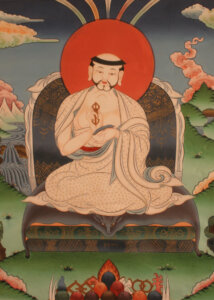
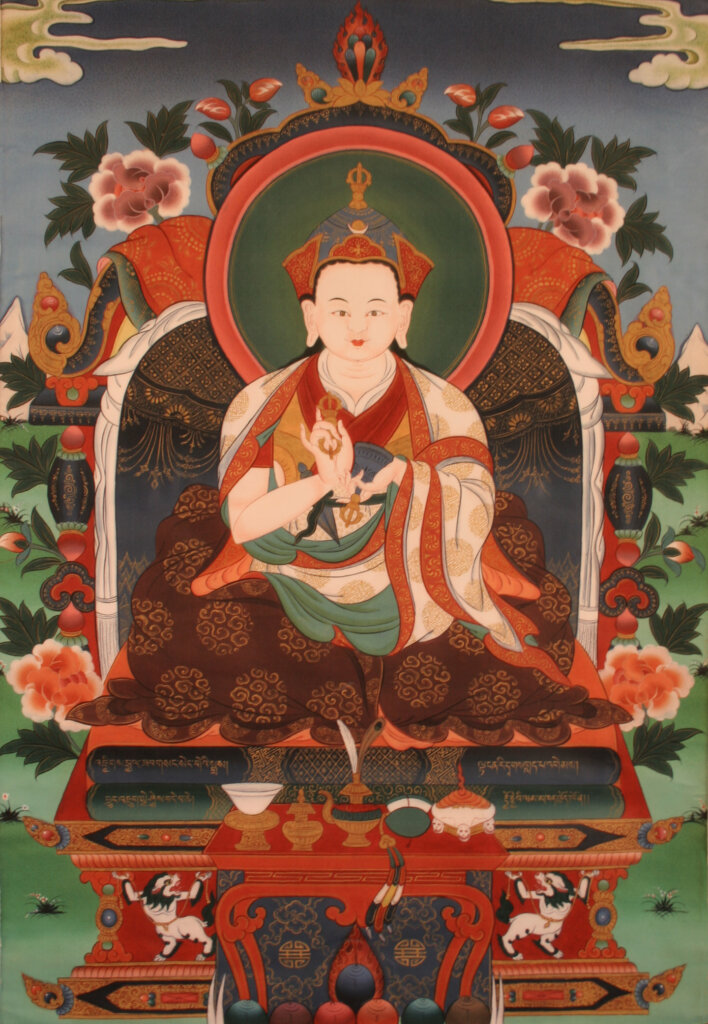
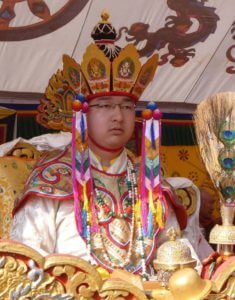
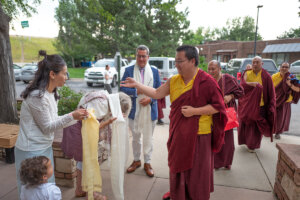
Dudjom Yangsi - Sangye Pema Shepa (1990-2022)
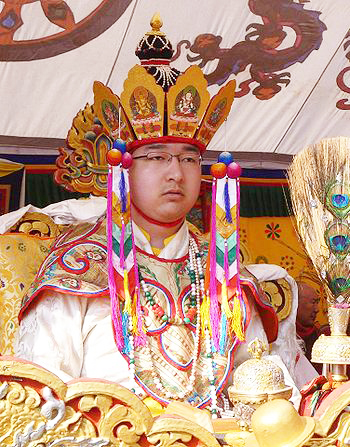
The following is a selection of the forthcoming The Ruby Rosary by Thinley Rinpoche, the son of the previous Dudjom Rinpoche, and the uncle to Dudjom Yangsi Rinpoche. In the foreword, Lama Tharchin relates the following:
This great being’s reincarnation is the supreme Nirmāṇakāya emanation Sangye Pema Shepa Drodul Rigdzin Trinley Drupe De, also known as Pema Ösel Pal Zangpo. His father was the great holy Treasure Revealer’s own son, Dola Choktrul Jigme Chökyi Nyima, and his mother is Pema Khandro, who has all the marks and signs of a Ḍākinī. In the year of the Iron Horse [1990], the lotus of his perfect form blossomed anew amid many amazing, auspicious signs.
Right from his early youth, his excellent propensities awakened, igniting the dynamic power of his innate supreme knowledge, an experience unique to the extraordinary liberated lives of great noble beings. Thus, he was able to read and write merely by glancing at words and letters. He received Kama and Terma empowerments, reading transmissions, and pith instructions from numerous learned and accomplished holy lineage masters, including the supreme sovereign master Kyabje Jigme Tsewang Thinley Norbu, who was his paternal uncle [the Treasure Revealer’s son], as well as the most senior of all of Kyabje Dudjom Rinpoche’s disciples, Kyabje Chatral Sangye Dorje and Gonjo Tulku Orgyen Chemchok.
Sangye Pema Shepa Rinpoche drank deeply of this nectar until his thirst was quenched. The force of his recollection of past lives has given him prodigious knowledge of boundless gateways to the Dharma of scripture and realization. Now, at the age of fifteen,* his qualities of scholarship, discipline, and kindness are completely unrivaled, and his enormously powerful enlightened activities are flourishing in every direction. He has accepted his role as a holy and courageous protector of the Great Secret Early Translation teachings and beings.
In 2018 Dudjom Yangsi came to the US and bestowed the entire Dudjom Tersar cycle of empowerments at Pema Osel Ling in California. Rinpoche also travelled extensively in the US during that trip, and we were deeply humbled by his visit to our office.
Rinpoche's Foreword to Taming of the Demons: From the Epic of Gesar of Ling
Previously, as the magical manifestation of Great Master [Padmasambhava],
You, Lion King Tamer of Māras [Gesar of Ling], through your blessings and power
Expelled the dark forces of the barbaric māras to the farthest shore,
Hoisted the victory banner of the Buddha’s doctrine high in the firmament,
And heralded in a celebratory time, a new golden age
Of the four endowments, like summertime in full bloom.
May all those glorious qualities of auspicious peace and well-being in the world
Bring us all great happiness now and always.
Thus, at the request of Lama Chönam, I, the one named Dudjom Sangye Pema Shepa, offered this aspiration prayer.
From the Foreword of The Ruby Rosary (2022), on the Lineage of Dudjom Lingpa and Dudjom Rinpoche
"Our world has many different ethnicities and languages, yet we all share the common wish for happiness. By relying upon the sublime life stories of this holy master, which are free from exaggeration and understatement, and upon his sacred writings, we will be able to follow his example and train in the precious Buddha Dharma, which is the source of every happiness and benefit."
This was written by Sangye Pema Shepa, the one bearing the title “Dudjom Incarnation,” on Ḍākinī Day in the eighth month of the Tibetan Earth Dog year [October 4, 2018]
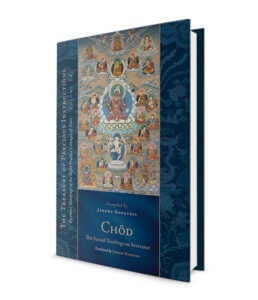
Matthew Kapstein on Dam Ngak (special instruction) based on the Treasury of Precious Instructions

Explore the Treasury of Precious Instructions
Home Page of the Treasury
History of the Collection
The Books: Overviews of Each Volume
Jamgön Kongtrul's Descriptive Catalog (Karchag)
Video Series
Audio Streaming and Podcast
> Matthew Kapstein on Dam Ngak (special instruction) based on the Treasury
Tibetan Resources on the Treasury from the Tsadra Foundation
Readers Guide to Jamgōn Kongtrul
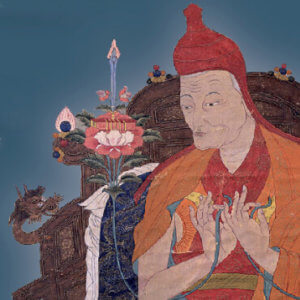

Matthew Kapstein on Dam Ngak in the Treasury of Precious Instructions
The following is Matthew Kapstein's paper from Tibetan Literature: Studies in Genre, one of the great collections of scholarly works on Tibetan literature. This paper focuses on Dam Ngak (gDams ngag) or special instructions. He uses the Jonang volume from Jamgon Kongtrul's Treasury of Precious Instructions as the basis.
There is a more complete version on Academia.edu as well for those wish to learn more, and we thank Matthew Kapstein for his permission to post it.
gDams ngag: Tibetan Technologies of the Self
The Tibetan terms gdams ngag (Skt. upadesa) and man ngag (Skt. amnaya, but sometimes also upadesa) refer broadly to speech and writing that offer directives for practice, whether in the general conduct of life or in some specialized field such as medicine, astronomy, politics, yoga or meditation. In any of these areas, they may refer to "esoteric" instructions, i.e., advice not usually found in theoretical textbooks but derived from the hands-on experience of skilled practitioners, and thus intended primarily for those who are actually engaged in the practice of the discipline concerned. Man ngag seems often to connote a higher degree of esotericism than does gdams ngag, particularly where both terms are employed together contrastively, and despite their essential synonymity.
In this short essay I shall focus on the category of gdams ngag, "instruction," as understood in connection with meditational and yogic practice. In this context, gdams ngag refers essentially to the immediate, heartfelt instructions and admonitions of master to disciple concerning directly liberative insight and practice. gDams ngag in this sense is, in the final analysis, a product solely of the interrelationship between master and disciple; it is the non-repeatable discourse event in which the core of the Buddhist enlightenment comes to be manifestly disclosed. It is in this sense, for instance, that we find the term used in narrating a signal event in the life of the famed rNying ma pa master Mipham Rinpoche (1846-1912):
One time, Mipham went into Khyentse Rinpoche's presence. "How did you apply yourself to experiential cultivation when you stayed in retreat?" he was asked.
"While pursuing my studies," Mipham answered, "I made conclusive investigations, and while performing the ritual service of the meditational deity in retreat I have taken care to see that I have reached the limits of the stage of creation."
"Those are difficult. The great all-knowing Longcenpa said, 'Not doing anything, you must come to rest right where you are.' I have done just that. By so resting I have not seen anything with white flesh and a ruddy complexion that can be called the 'face of mind.' Nonetheless, if I were to die now it would be all right. I do not even have a grain of trepidation." So saying, Khyentse Rinpoche laughed aloud. Mipham [later] said that he understood that to be the guru's instruction (gdams ngag).
(Dudjom Rinpoche, 1991: 876-877)
gDams ngag, then, is the articulation of the dynamic interaction between master and disciple; it expresses the essentially hermeneutical movement in which the disciple is reoriented in the depth of his or her being to the goal of the teaching. Insofar as the Buddha's entire doctrine is held to be directed to that goal, the achievement of perfect enlightenment on behalf of oneself and all creatures, all expressions of Buddhadharma may be in a certain sense termedgdams ngag (cf. 'Jam mgon, DNgDz, vol. 12: 626-630). Nevertheless, the term has been thematized in Tibetan Buddhist discourse to refer above all to those meditational and yogic instructions that most frequently form the basis for systematic salvific practice. One must include here also the innumerable writings on blo sbyong, "spiritual training/purification," and the entire genre of khrid yig, "guidebooks," i.e., practical manuals explicating particular systems of meditation, yoga and ritual. It is in this context that gdams ngag has come to form the basis for an important set of distinctions among Tibetan Buddhist traditions, corresponding in general to distinctions of lineage, while crosscutting distinctions of sec t.2 These systematic approaches to liberation through meditation and yoga, which will be our concern here, may be thought to be the quintessential Tibetan "technologies of the self."
There is no single classification of the many traditions of gdams ngag that is universally employed by Tibetan Buddhist doxo graphical writers. From about the thirteenth century onwards, however, the preeminence of certain particular traditions gave rise to a characteristic scheme that we encounter repeatedly, with small variations, throughout Tibetan historical, doctrinal and bibliographical literature.4 According to this, there are eight major gdams ngag traditions, which are referred to as the "eight great conveyances that are lineages of attainment" (sgrub brgyud shing rta chen po brgyad). The paradigmatic formulation of this classificatory scheme is generally attributed to 'Phreng bo gTer ston Shes rab 'od zer (Prajftarasmi, 1517-1584), whose verses on this topic are widely cited by Tibetan authors ('Jam mgon, DNgDz, vol. 12: 645- 646). The "eight great conveyances" as he enumerates them may be briefly explained as follows:
- The sNga 'gyur rnying ma, or" Ancient Translation Tradition," derives its special gdams ngag primarily from the teachings of Padmasambhava and Vimalamitra, eighth-century Indian Buddhist masters who visited Tibet, and from the great Tibetan translators who were their contemporaries, especially Pa gor Bairo tsa na. Of the tremendous body of special gdams ngag belonging to the rNying ma tradition, most widely renowned are those concerned with the meditational teachings of rDzogs chen, the Great Perfection.
- The bKa' gdams, or "Tradition of [the Buddha's] Transmitted Precepts (bka') and Instructions (gdams)," is traced to the activity of the Bengali master Atisa (982-1054) and his leading Tibetan disciples, notably 'Brom ston rGyal ba'i 'byung gnas (1104-1163). It is owing to its special role in maintaining the vitality of teachings derived from the bKa' gdams tradition that the dGa' ldan or dGe lugs order, founded by rJe Tsong kha pa Blo bzang grags pa (1357- 1419), is often referred to as the New bKa' gdams school (bKa' gdams gsar ma). The bKa' gdams tradition specialized in gdams ngag relating to the cultivation of the enlightened attitude (bodhicitta, byang chub kyi sems), the union of compassion and insight that is characteristic of the Mahayana.
- Lam 'bras bu dang bcas pa, the "Tradition of the Path with its Fruit," is derived ultimately from the teachings of the Indian mahasiddha Virupa, and was introduced into Tibet by 'Brog mi lo tsa ba Sakya Ye shes (992-1072). This tradition of esoteric practice, emphasizing the Hevajra Tantra, became from early on a special concern of the Sa skya pa school, and so has been primarily associated with Sa skya and the several Sa skya pa suborders, such as the Ngor pa and Tshar.
- The Mar pa bKa' brgyud, or "Succession of the Transmitted Precepts of Marpa," has as its particular domain the teachings of the Indian masters Tilopa, Naropa and Maitripa as transmitted to Mar pa Chos kyi blo gros (1012-1097), the translator of lHo brag. His tradition of gdams ngag stresses the Six Doctrines (chos drug) of yogic pratice-inner heat, the apparitional body, lucid dreaming, inner radiance, the transference of consciousness at death, and the teachings of the intermediate state (bar do)-as well as the culminating meditations of the Great Seal (mahamudra, phyag rgya chen po).
$39.95 - Paperback
By: Jose Cabezon & Rebecca Redwood French & Jamgon Mipham & Roger R. Jackson & Per Kvaerne
Available Books from the Treasury of Precious Instructions
The proliferation of lineages adhering to the teachings of Mar pa, those of his foremost disciple, Mi la ras pa (1040-1123), and those of the latter's main students Ras chung rDo rje grags (1083- 1161) and sGam po pa bSod nams rin chen (a.k.a. Dwags po Lha rje, 1079-1153) was very widespread, and the many teaching lineages that arose among their followers almost all created their own distinctive formulations of the bKa' brgyud gdams ngag. The four "great" bKa' brgyud orders (bKa brgyud che bzhi) were founded by sGam po pa's immediate disciples, among whom Phag mo gru pa rDo rje rgyal po's (1110-1170) leading disciples founded eight "lesser" orders (chung brgyad). (The terms"great" and "lesser" refer solely to their relative proximity to sGam po pa, and imply neither quantitative nor qualitative judgment.) The first Karmapa hierarch, Dus gsum mkhyen pa (1110-1193), is numbered among the four "greats," while 'Bri gung skyob pa 'Jig rten gsum mgon (1143-1217) was prominent among the founders of the eight "lesser" orders. Among the eight is also counted Gling rje ras pa Padma rdo rje (1128-1188), whose disciple gTsang pa rGya ras (1161-1211) founded the 'Brug pa bKa'brgyud order, which in turn gave rise to several major suborders. (The 'Brug pa later established itself as the state religion in Bhutan, a position it retains at the present time.) Mar pa bKa' brgyud teachings have been widely transmitted among non-bKa' brgyud pa orders, for instance among the dGe lugs pa, a considerable portion of whose esoteric gdams ngag originated in the Mar pa bKa' brgyud tradition.
- The Shangs pa bKa' brgyud, the "Succession of the Transmitted Precepts of Shangs Valley," is traced back to Khyung po rnal 'byor Tshul khrims mgon po of Shangs (d. ca. 1135), a master whose foremost teacher was the akinz Niguma, said to have been the sister or wife of Naropa. The special teachings of the Shangs pa tradition, which are similar to those of the Mar pa bKa' brgyud tradition, differing primarily in points of emphasis, were widely influential. Despite the almost complete absence of distinctive Shangs pa institutions, they were transmitted within the Mar pa bKa' brgyud, dGe lugs, Jo nang and rNying ma orders. The Shangs pa teachings have aroused considerable interest among Buddhists in the West owing to the widespread activity of their leading con temporary proponent, the late Kalu Rinpoche Rang byung kun khyab (1905-1989).
- The closely related teachings of Zhi byed, "Pacification," and gCod yul, "Object of Cutting," originated respectively with the enigmatic Indian yogi Pha Dam pa Sangs rgyas (d. 1117) and his remarkable Tibetan disciple, the yogini Ma cig Lab kyi sgron ma (ca. 1055-1143). Though schools specializing in Pacification were very widespread from the twelfth to fourteenth centuries, the teaching all but disappeared in later times. The Object of Cutting, however, permeated the entire Tibetan Buddhist tradition and is today preserved by all Both of these systems of gdams ngag seek to bring about the realization of liberating insight as it is un derstood in the "Perfection of Wisdom" (Prajfi.aparamita) sutras by means inspired by esoteric Buddhist practice. This takes par ticularly dramatic form in the traditions of the Object of Cutting, whose exquisite liturgies involve the adept's symbolic offering of his or her own body as food for all beings throughout the universe.
- rDo rje'i mal 'byor, the "Yoga of Indestructible Reality," refers to the system of yoga associated with the Kalacakra Tantra, as transmitted in Tibet initially by Gyi jo lo tsa ba Zla ba'i 'od zer during the early eleventh century. Later traditions that were particularly influential include those of Zhwa lu and Jo nang. The former came to be favored in the dGe lugs pa school, and contin ues to be transmitted in that order today, above all by H. H. the Fourteenth Dalai Lama. The latter fell into decline in the wake of the suppression of the Jo nang pa sect during the seventeenth cen tury, but was later revived in eastern Tibet, particularly by the proponents of the so-called Eclectic Movement (Ris med), during the nineteenth century.
- rDo rje gsum gyi bsnyen sgrub, the "Service and Attainment of the Three Indestructible Realities," represents an extremely rare tradition, closely allied with the Kalacakra Tantra, and stemmingfrom the teaching of the divine Vajrayogini, as gathered by the Tibetan siddha O rgyan pa Rin chen dpal (1230-1309) during his travels in the northwestern quarters of the Indian subcontinent. The teaching was popularized by O rgyan pa's successors during the fourteenth century, when several commentaries on it were composed, but subsequently seems to have lapsed into obscurity. 0 rgyan pa also figures prominently as a transmitter of several of the major bKa' brgyud lineages, notably the 'Brug pa and Karma pa traditions.
During the nineteenth century this scheme of the "eight great conveyances" provided the basis for the great Tibetan anthology of gdams ngag, the gDams ngag mdzod ("The Store of Instructions"), compiled by 'Jam mgon kong sprul Blo gros mtha' yas (1813-1899), one of the leaders of the Eclectic Movement. "The Store of Instructions" provides encyclopedic and balanced treatment of all of the major Tibetan Buddhist gdams ngag traditions and several of the more important minor ones, and preserves scores of instructional texts by some of the most famous Tibetan authors as well as by many who are less well-known. It includes in its compass en tire previous collections of gdams ngag materials, such as the Blo sbyong brgya rtsa ("The Hundred [Teachings on] Spiritual Training and Purification"), representing the essential gdams ngag of the bKa' gdams traditions ('Jam mgon, DNgDz, vols. 2-3), and the Jo nang khrid brgya dang brgyad ("The Hundred and Eight Guidebooks of the Jo nang pas"), an eclectic compilation by Jo nang rje btsun Kun dga' grol mchog (1507-1566) that is in certain respects a precursor to "The Store of Instructions" itself (DNgDz, vol. 12).
Because all of the traditions mentioned above have generated abundant literature devoted to their own distinctive gdams ngag, including both texts immediately concerned with the details of practical instruction and systematic treatises that attempt to formulate the distinctive perspective of a particular gdams ngag tradition in its relation to Buddhist doctrine broadly speaking, it will not be possible to attempt to survey here the extraordinary volume of materials that are illustrative of these many differing traditions. Indeed, one may well wonder at this remarkable proliferation of the Tibetan technologies of the self: if, after all, the goal is in any case the achievement of buddhahood here and now, then why complicate matters by providing those who wish to follow the path with such a dizzying array of road maps? The traditional view is that, like a well-equipped pharmacy, the Buddha's teaching provides appropriate remedies for the many different afflictions of living beings; the myriad gdams ngag of Tibetan Buddhism may thus be seen to constitute a spiritual pharmacopeia. The medi cal analogy, however, by suggesting that, to a certain degree at least, eclecticism and pluralism are to be welcomed for the therapeutic enrichment they provide, points to a complicated cluster of problems: briefly, how is one to form a comprehensive vision of the totality of possible approaches to the path, that remains sufficiently critical to exclude false paths, without at the same time undermining the positive values of pluralism? Kong sprul's eclectic and even unitarian approach to the difficulties that arise here finds its complement in the attempt to elaborate and defend favored systems of gdams ngag through doctrinal apologetics, whether these be relatively catholic in outlook, or narrowly sectarian. gDams ngag, essentially the pithy expressions of contemplative experience, thus become the basis for renewed dogmatic system-building. This occurred very prominently in certain of the schools of Tibetan Buddhism-consider in this regard the massive philosophical elaboration of the Great Perfection (rDzogs chen) teachings of the rNying ma school,15 or of the Great Seal (Mahamudra, Phyag chen) precepts of the several bKa' brgyud orders,16 or of the originally bKa' gdams pa Path Sequence (Lam rim) instructions among rJe Tsang kha pa and his successors.17 The products of these and other similar doctrinal syntheses certainly represent some of the most creative developments in the field of Tibetan Buddhist thought. The exploration of the many ramifications of such system-building, however, lies beyond the scope of this small contribution.
In order to provide the reader with a concrete example of the teaching of a particular tradition of gdams ngag, I give below, in the manner of an appendix, some short translated excerpts from "The Hundred and Eight Guidebooks of the Jo nang pas," concerning the history and the actual teaching of the practical dimen sion of the approach to Madhyamaka thought known as dBu ma chen po ("The Great Middle Way"). It is important to recall that gdams ngag traditions are not thought of ahistorically in Tibet: each such tradition has its unique origin, history of transmission, and relevance to a special historical setting. Thus, even a very terse historical note, such as the one given here, helps to situate a given gdams ngag for the Tibetan reader or auditor. The equally terse presentation of the teaching itself reflects what is in fact a series of rubrics, intended to guide an expanded course of oral explanation. The strictly maintained correlation between history and doc trine reinforces the role played by these instructions as the practi cal technologies of the self, for in a tradition's history we find the concrete exemplifications of the human ideals that are to be real ized by one's submission to the course of training imposed by that same tradition's gdams ngag.
I have chosen this particular extract to honor Geshe Lhundrup Sopa, to whom the present volume is dedicated, for Geshe-la has been a preeminent exponent of Madhyamaka thought through out the nearly three decades that he has graced Buddhist Studies in the special setting of our own time and place. Those who have had the good fortune to study with him will no doubt supplement the topics briefly enumerated here with their own recollec tions of Geshe-la's learned expositions of related subject matter.
From the "History of the Hundred and Eight Guidebooks":
Concerning the dBu ma chen po'i khrid ["The Guidance on the Great Middle Way"]: it was received by the bodhisattva Zla ha rgyal mtshan from the Newar Penya pa, one who belonged to the lineage of Nagarjuna, father and son [i.e., Nagarjuna and Aryadeva]. He taught it to rDzi lung pa 'Od zer grags pa, and he to Gro ston, who propounded it widely. There are some who hold that this was the lineage of the dBu ma lta khrid ["The Guidance on the View of the Middle Way"] that came to the venerable Re mda' ha from mNga' ris, in West Tibet, but that is uncer tain. This is [also] called the gZhung phyi mo'i dbu ma ["The Middle Way according to the Original Texts," i.e., of Nagarjuna and Aryadeva], and so is the ancient tradition, not yet divided into Prasangika and Svatantrika. That which is distinguished as the special doctrine of Red mda' ha, however, is the unblemished adherence to the Prasangika tradition, that follows the texts of the glorious Cand rakirti.
From the "Text of the Hundred and Eight Guidebooks":
dBu ma chen po'i khrid yig ["The Guidebook of the Great Middle Way"]: Concerning "The Guidance on the Great Middle Way": One begins by going for refuge and cultivating the enlightened attitude [bodhicittaJ. Then, investigating the abiding nature of appearance and emptiness, appearance is [determined to be] just this unimpeded and ever-varied arising. As for the understanding of emptiness, however, it is neither the emptiness that follows after a pot has been shattered, nor is it the emptiness that is like the pot's emptiness of being a blanket, nor is it the emptiness of sheer nothingness, like that of a hare's horn. It is, rather, self-presenting awareness's emptiness with respect to substantial essence at the very moment of appearance. And that, because it is empty of veridicality in terms of the relative, is apparition-like, and, because it is absolutely empty of essence, is sky-like. In brief, whatever the manner of appearance, there is not even so much as the tip of a hair that is veridically estab lished. This is not the emptiness of [appearance's] cessation, nor the emptiness of the fabricated. It is precisely the emptiness that has reference to appearance itself.
When cultivating this experientially, you adopt the bodily disposition of the meditational posture. First you consciously strive somewhat [to recall and to concentrate upon the understanding of appearance and emptiness taught above]. In the end you re lax [that deliberate striving]. Beginners should practice frequently in short sessions.
When you have thus cultivated the meditation, the three spiri tual experiences of clarity, bliss and nonconceptuality arise. It will come about that mind will not grow excited about that at all, but will remain at ease, like the hand resting just where you place it. Your awareness becomes absorbed in simplicity, in the simple disposition of reality. (1) The inception of one-pointed ness that remains unexcited with respect to [both] untarnished clarity of mind and circumstantial objects is called "tranquil ity" (samatha, zhi gnas) while (2) its nonconceptual nature, like the circle of the sky that is free from apprehended referent, is called "insight" (vipasyana, lhag mthong). (3) Complete absorption is untouched by the intellect that apprehends objectives, and (4) your course of conduct involves the awareness of the qualities of dream and apparition in the aftermath [of meditative absorption]. You experientially cultivate [this teaching] in these four ways. When hairline discriminations of being and nonbeing forcefully arise, you gradually develop your skill, and it is said that in this way you will come to meet the face of that abiding nature that is unpolluted by the taints of the conceptual elaborations of the eight limitations.
The heart of all [kun] doctrines is the Great Middle Way: To delight [dga'] the wise, it is completely free [grol] From the range of unreflective and foolish meditations;
It is the great path of supreme [mchog] freedom from limitations.21This was compiled from the guide[book] of the bodhisattva Zla [ba] rgyal [mtshan ).
Continue to next page: Tibetan Resources on the Treasury from the Tsadra Foundation or discover more about Jamgön Kongtrul by exploring Jamgön Kongtrul Reader's Guide
SNOW LION NEWSLETTER ARCHIVE
An Interview with Lama Tharchin Rinpoche
The following is from the Snow Lion Newsletter, Winter Supplement 1995
Snow Lion: Rinpoche, can you tell us something about your activities here in the West?
Lama Tharchin Rinpoche: Last time I saw my root teacher, His Holiness Dudjom Rinpoche, his final instructions were for me to take care of the doctrine by teaching and establishing the Dharma. He told me that since I have been educated in Dharma and have gained experience in retreat, it was now time to share what I have learned with others. His Holiness Dudjom Rinpoche's son, Dorje Chang Kyabje Dungse Thinley Norbu Rinpoche, advised me to stay and teach in America where the doctrine has not been previously established.

Kyabje Dudjom Rinpoche
When I reflect on my teacher's request and what I want to do with the rest of my life, and I think about what I can give to America and the West, I feel the most profound gift I could possibly give would be the gift of inner peace. We are so wealthy materially, yet we lack the ability to find true and lasting happiness. Each of us has an inherent enlightened Buddha-nature and the ability to find inner peace and contentment. The way to find and reveal the inconceivable qualities within each of us is through the path and techniques of Dharma.
This is the way we can remove the mental suffering and delusion that exists within the samsaric cycling of existence. The unbroken lineage of the Vajrayana teachings can only be held and continued for future generations through education and practice. Education requires the establishment of a college. Practice requires people to do retreat in all forms, including the traditional three-year retreat. Due to my teacher's encouragement, my life goal is to establish these two vehicles for rooting the essence of the Vajrayana teachings in the West.
Two and a half years ago we established the three-year retreat. There are currently eleven people in retreat. We are also in the process of translating a complete treasury of sutra and tantra, a thirteen volume text called the Do Gyud Dzod. [Note: First volume published in 2015 as The Complete Nyingma Tradition Books 1-10] Only one copy of these volumes exists in Tibet, and we have now made a copy and brought it here. When this translation project is complete and if impermanence doesn't come too soon, I would like to establish a college under the direction of Lama Gyaltsen Rinpoche from Vajrayana East in Nepal and Tulku Thubten Rinpoche [Anam Thubten], who is a resident lama at Pema Osel Ling. Since 1986 I have been living in the Santa Cruz area where I have been directing Vajrayana Foundation and Pema Osel Ling retreat and conference center. I feel very pleased that so much progress has been made since I came to the West.
In addition to establishing the three-year retreat and beginning a college, we have also created the Institute for the Preservation of Tibetan Sacred Art. Our plan is to create symbolic supports for bringing enlightened energy to the earth in the form of stupas, statues, libraries and temples, which increase the wisdom and compassion of all sentient beings. So far at Pema Osel Ling, we have finished sculpting a large statue of Guru Rinpoche, which is now being painted and gilded, and an elaborate and permanent sand mandala of Guru Rinpoche's pure' land.
My overall goal is to continue to establish the pure and unbroken Dudjom Tersar lineage in the West. Wherever one can establish a pure lineage, then whoever has the desire to hold that lineage will be able to. This preserves that lineage for the benefit of all beings, now and in the future. Today Tibetan culture and doctrine is very fragile. Some of the lineages of Vajrayana Buddhism have become very thin and are in danger of being lost. My intention is to train Westerners to become lamas who are both educated and experienced practitioners. In this way, the Dudjom Tersar lineage will be strengthened. As Westerners begin to teach, the Dharma can become integrated into this culture without losing the purity of the lineage. Even though I cannot accomplish all of these goals in my lifetime, I hope that others will complete what I have begun.
Due to his great compassion and wisdom, and our extremely good fortune, Dungse Thinley Norbu Rinpoche has granted our request and has agreed to give next summer the entire cycle of Dudjom Lingpa and His Holiness Dudjom Rinpoche's empowerments, transmissions and teachings, which is the Dudjom Tersar lineage. Good fortune of this kind is almost impossible to find, especially for a humble Dharma center like ours. This will be a major event for the Nyingma lineage and Vajrayana tradition.
SL: Please tell us about your experiences with Dudjom Rinpoche.
LTR: Actually, my father sent me to study and train with His Holiness Dudjom Rinpoche in 1943 when I was eight years old. I moved to his monastery, Lama Ling, in Gongpo. My whole childhood was devoted to education, then later I went into retreat.
SL: How long did you stay in retreat with His Holiness?
LTR: First, I spent five years by myself in retreat, then I did a three-year retreat with a group at His Holiness's place. I practiced and received teachings from Dudjom Rinpoche until I escaped to India in 1960. I then traveled with him until 1964 when he established a center in Orissa where I stayed until 1975. My whole life was devoted to serving him and his centers.
SL: Can you tell us something about your relationship with his son Dungse Thinley Norbu Rinpoche?
LTR: We grew up together in Tibet. Later, as I became educated and finished retreat, my understanding improved and I realized how truly amazing he is. I thought that no one in the world could write like Dudjom Rinpoche, and then I read Dungse Thinley Norbu Rinpoche's books. I couldn't believe how sublime his work is, just like his father's. I feel that their qualities are inseparable, and that he is exactly the same as his father.
I received Dzogchen teachings and empowerments from him and became his student Along with His Holiness Dudjom Rinpoche, Lama Sherab Rinpoche and Chatral Rinpoche, I consider Dungse Thinley Norbu Rinpoche to be my root guru.
Dungse Thinley Norbu Rinpoche is an emanation of the great Mahasiddha Longchenpa, whose later emanation was Jigme Lingpa. In his previous lifetime, he was the son of Dudjom Lingpa. Now I can see that Longchenpa, Guru Rinpoche, Dudjom Rinpoche, and Dungse Rinpoche are exactly the same.
SL: Do you think it is important for people to attend the Dudjom Tersar transmissions in July?
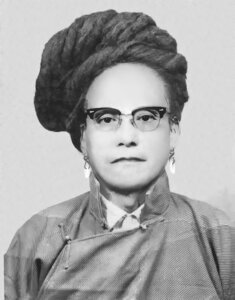
Lama Sherab Rinpoche, Lama Tharchin's uncle
LTR: Yes, absolutely. This is a once-in-a-lifetime opportunity. Dungse Thinley Norbu Rinpoche never gives this type of advanced teaching and empowerments to the public. He is a totally hidden and secret Lama. Due to his incredible compassion and kindness he is willing to pass this lineage to us.
I was recently in Nepal, and when I told people of his intentions, they couldn't believe it. They said that they normally never even get a chance to see him. They were so shocked to hear that he would transmit the whole cycle of empowerments and teachings. This is our incredible good fortune. Since this is such a rare opportunity, I want to let everyone know about this extremely auspicious occasion. Since His Holiness Dudjom Rinpoche passed away, this lineage has already grown weaker. Now we have a wonderful opportunity to make it strong again.
SL: Many people here have very busy lives and will not be able to attend the entire four weeks. Would it be acceptable to attend part of the time?
LTR: Yes, of course, whatever you can do is wonderful. I hope that many of our Dharma friends will be able to come.
***
For further information on the Dudjom Tersar empowerments, write to Dudjom Empowerments, 2013 Eureka Canyon Road, Corralitos, CA 95076, or call 408-724- 2752. The Venerabla Dzogchen master of Vajrayana Buddhism. He is the tenth lineage holder of the Repkong Ngakpas or yogis, which was the largest community of non-monastic practitioners in Tibet. He is loved not onlyfor his inspiring teachings of Buddhist philosophy and meditation, but also for his accomplishments as a master artist. *
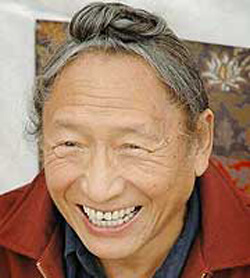
The Complete Nyingma Tradition from Sutra to Tantra, Books 1 to 10
$49.95 - Hardcover
The Complete Nyingma Tradition from Sutra to Tantra, Books 15 to 17
$59.00 - Hardcover
This includes a foreword by Lama Tharchin Rinpoche
Books Related to the Dudjom Tersar
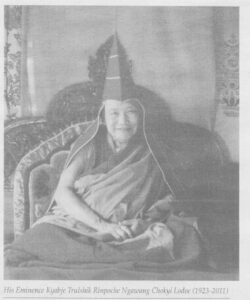
| The following article is from the Autumn, 2011 issue of the Snow Lion Newsletter and is for historical reference only. You can see this in context of the original newsletter here. |
Honoring
ONE OF THE GREAT MASTERS of Tibetan Buddhism,
His Eminence Kyabje Trulshik Rinpoche Ngawang Chokyi Lodoe (1923-2011)
ONE OE THE GREAT MASTERS OF Tibetan Buddhism, His Eminence Kyabje Trulshik Rinpoche, passed away on September 2, 2011. Most recently he served as head of the Nyingma School, but was known as a leading proponent of the Rime (non-sectarian) approach.
The heart son of both Dudjom Rinpoche and Dilgo Khyentse Rinpoche, he also gave rare Nyingma and Dzogchen teachings to His Holiness the Dalai Lama.
Kyabje Trulshik Rinpoche Ngawang Chokyi Lodoe was born in Tibet in 1923. He was recognized at the age of four as the reincarnation of his own heart lama, Trulshik Tendru Dorje, a famous discoverer of hidden treasures (terma). He was also considered to be the manifestation of Lord Buddha's disciple Ananda, as well as of Aryadeva and other key figures in Buddhism.
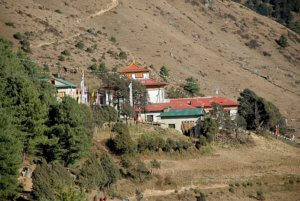
Thupten Choling Monastery (Photographer: Sergey Pashko)
In 1959, when His Holiness the Dalai Lama went into exile in India, Trulshik Rinpoche also fled across the Himalayas into the Everest region of Nepal. Later, he and his followers established Thupten Choling monastery, now the largest monastery in Nepal with 150 monks and 350 nuns studying and meditating there.
His direction of the annual Mani Rimdu festival of masked dance-drama is documented in Richard Kohn's film Lord of the Dance, Destroyer of Illusion (1986), the title of which is in part derived from his name, Trulshik Rinpoche, the Precious Destroyer of Illusion.
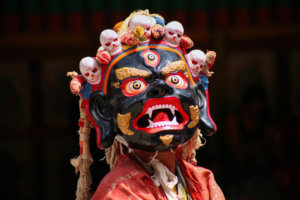
For more information:
Originally titled: Lord of the Dance ~ Destroyer of Illusion (1985)
Narrated by Richard Gere
Directed by Richard Kohn
NY Times Article: Film: Documentary on Tibetan Ritual
The filming took place in the autumn of 1984 in the Mount Everest area of Nepal, where a Tibetan lama, Trulshig Rinpoche, settled after being driven from his native land during the Chinese Cultural Revolution.
Website: Buddhist Film Foundation Festival Media
Trailer: Destroyer of Illusion
The retreat community and monastery established by Kyabje Trulshik Rinpoche in the 1960s in the Solu Khumbu district of northeastern Nepal.
Kyabje Trulshik Rinpoche's (1923-2011) Reincarnation:
Article: Trulshik Rinpoche’s successor recognized
The reincarnation, Ngawang Tenzin Choekyi Lodoe Rabsel, was born in Kathmandu on July 25, 2013. The announcement about his recognition was made on July 6th to coincide with His Holiness the Dalai Lama’s 80th birthday.
Web Announcement: Tulku of Trulshik Rinpoche Recognized
Related Books
$29.95 - Paperback
By: Andreas Doctor & Cortland Dahl & Dharmachakra Translation Committee & Getse Mahapandita Tsewang Chokdrub & Jigme Lingpa & Patrul Rinpoche
The Life of Jamgon Kongtrul the Great
$39.95 - Hardcover
A Feast of the Nectar of the Supreme Vehicle
$69.95 - Hardcover
By: Asanga & Jamgon Mipham & Maitreya & Padmakara Translation Group
The Complete Nyingma Tradition from Sutra to Tantra, Books 1 to 10
$49.95 - Hardcover
The Complete Nyingma Tradition from Sutra to Tantra, Book 13
$39.95 - Hardcover
The Complete Nyingma Tradition from Sutra to Tantra, Book 14
$39.95 - Hardcover
The Complete Nyingma Tradition from Sutra to Tantra, Books 15 to 17
$59.00 - Hardcover
A Torch Lighting the Way to Freedom
$34.95 - Paperback
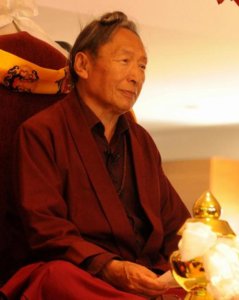
The Practice of Tibetan Treasure Vases
| The following article is from the Autumn, 2003 issue of the Snow Lion Newsletter and is for historical reference only. You can see this in context of the original newsletter here. |
| Note: The Treasure Vase project created by Lama Tharchin Rinpoche as envisioned in the article below is now available on the Treasure of Abundance site. |
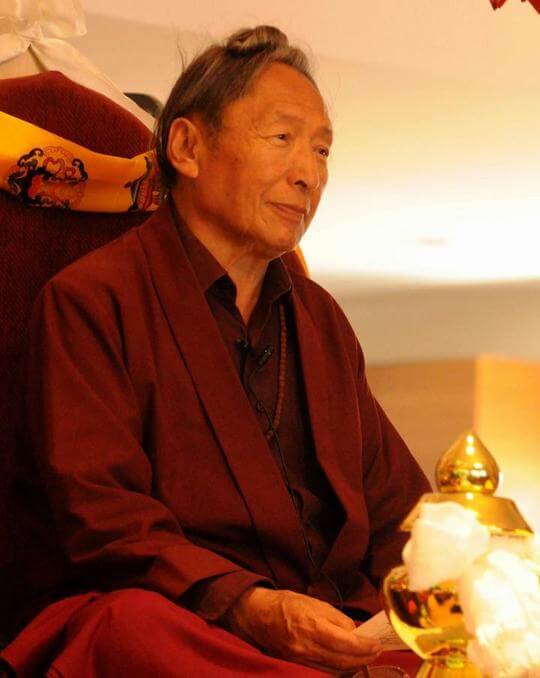
Through his wisdom and compassion, Padmasambava gave specific instructions for the creation of treasure vases to assist with the healing of the environment and the restoration of vital energy during these degenerate times. The treasure vase is an ancient remedy that can replenish the essence of the elements—earth, air, fire, water, and space. When the outer environment is purified, beings are released from suffering caused by pollution and are therefore rejuvenated. This restores the energy to all realms.
For the human realm, the treasure vase has the power to magnetize wealth and abundance, improve health, and remove obstacles to long life. Its effects help pacify anger and warfare and increase wisdom and compassion for all.
Padmasambava prescribed the sacred objects that fill the treasure vase. The conch shell supports the life essence of the god realm of joy. Turquoise supports the life essence of the human realm of intelligence. Crystal supports the life essence of the naga realm of wealth. The cowrie shell supports the life essence of the dakinis, and iron pyrite supports the life essence of the local protectors of the environment and the practitioners within it.
The vases are filled to the brim with medicine balls whose most important ingredient is "mother pills." The main substances in mother pills are called yang-dzay rilbu (essential wealth substance pills.) Padmasambava originally hid these substances for future generations of beings. Many treasure revealers discovered these hidden substances. His Holiness Dudjom Rinpoche collected the substances from the ten-gam (treasure collections) of Mipham Rinpoche, Mindroling Terchen, and Khyentse Rinpoche, and many other precious substances created by sublime beings. From these substances Dudjom Rinpoche made the original "mother pill."
Lama Tharchin Rinpoche received original "mother pills" from Dudjom Rinpoche and expanded them. He added the twenty-five precious substances: the five precious jewels, the five precious essences, the five precious medicines, the five precious scents, and the five precious grains; plus tsa-sum (three roots), tsi-zhi (four flower essences), nyingpo-nga (five essences) and zangpo-druk (six excellences). He also added a very rich collection of jewels and minerals: opals, diamonds, emeralds, sapphires, rubies, turquoise, coral, pearl, dzi stone, chong stone, gold silver, copper, and so on: and additional precious substances such as soil, stone, and water collected from many of the world's holy and famous places.
Also inside the vases are dutsi (a holy substance that transforms all negativity into wisdom), ten-du rilbu (a collection of relics from countless Buddhas), pictures of the wealth deity Khandro Norlha, wealth mantras, and khorlos (written diagrams expressing wealth potential), which increase merit, prosperity, and abundance with the intention to benefit all beings.
Upon completion, the treasure vases are consecrated in a seven day ceremony.
For centuries, Tibetans have kept treasure vases in their homes, buried them in the earth, or placed them in bodies of water. The Venerable Lama Tharchin Rinpoche created and oversees the Vajrayana Foundation Treasure Vases. Rinpoche trained throughout his life in ritual art and ceremonies with His Holiness Dudjom Rinpoche and other great masters such as Lama Sherab Rinpoche. Snow Lion is honored to be able to offer these wonderful vases.
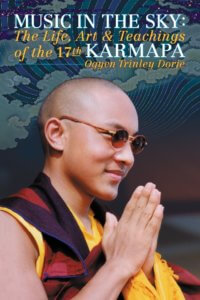
Life, Art and Teachings of the 17th Karmapa
| The following article is from the Spring, 2003 issue of the Snow Lion Newsletter and is for historical reference only. You can see this in context of the original newsletter here. |
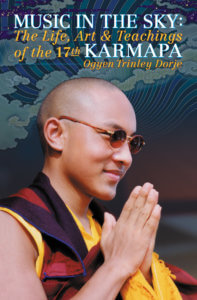
The Karmapa and Music in the Sky
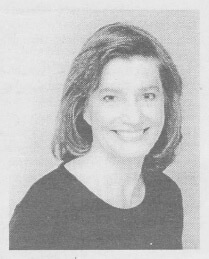
Michele Martin is the author of Music in the Sky: The Life, Art & Teachings of the 17th Karmapa.
An Interview with Michele Martin
How did you come to write "Music in the Sky?"
It's hard to say when you start something because there's always causes behind causes. I went to Tsurphu [Karmapa's monastery in Tibet] in July 92, not long after the Karmapa returned there in June. I was working with a film crew, translating, and his parents were there, staying at the monastery. I came to know his mother quite well; we spent a lot of time together.
One day she turned to look at me very clearly and she said, "When His Holiness comes out of Tibet and goes abroad, please help him."
And I said, "I will." It was a very deep commitment although I didn't know what it would be or how, but there was definitely a very strong connection that was made. So that was there as a basic condition of things.
After the Karmapa escaped to India in January 2000, I went to Dharamsala with Thrangu Rinpoche. There was a meeting of the high Kagyu lamas to decide what to do now that he was out of Tibet. And at the end of the meeting there was an evening celebration that was an offering to all the lamas who had come; as part of it, they had put to music a song that the Karmapa had written while escaping.
It's very beautiful and I thought, "I'd love to translate that." I have had a particular joy in reading poetry from childhood. I've translated poetry from Tibetan—the Kagyu lineage is a lineage of song and poetry. So I found a copy and translated it—and that was a beginning.
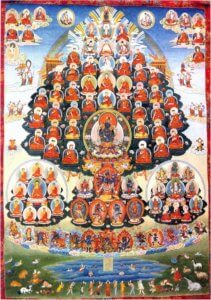
Kagyu Refuge Tree
The contents of the book are so rich, ranging from the dramatic stories of his escape, to his recent teachings, to the history of the Karmapas. How did you find all this great material?
I interviewed his sister, who took care of him when he was young and remembered the stories about him at a young age. And I talked to the people who had escaped with him. And to some who were involved in his recognition of some young tulkus. That's a special ability of the Karmapas—to recognize tulkus.
At a press conference we held in India I noticed that the press knew very little about the historical background of the Karmapa, so I wrote a brief history of the Karmapas. And I added a more traditional history so that people would see how Tibetans view their own history—they view it in quite a mythopoetic way. And then there were poems of the 16th Karmapa that were prophetic of the future.
The Karmapa knew I was working on the book and that I liked poems. Sometimes, at Gyuto, I'd be walking down the hall and he would suddenly appear and pull a poem out of his pocket and hand it to me.
the best teachings are those that meet the minds of the people who are there. He seems to have a unique ability to do that.
You translate for His Holiness the Karmapa. What's that like?
He's so awe-inspiring it's very difficult to keep your wits about yourself to translate. He has such a powerful presence. In the beginning when he would say something and then turn and look at me, he was so stunning that it was very hard to keep any words in my mind. It took a while getting used to the powerful presence he is.
I never knew what he was going to talk about. Often with lamas there's a text you can prepare and you know ahead of time generally what they'll be speaking about. With the Karmapa he would speak just whatever it was that he wanted to speak about that day. It kept me always on my toes. I was impressed: he seemed to be able to choose a topic that fit the people who were there that day; they say that the best teachings are those that meet the minds of the people who are there. He seems to have a unique ability to do that.
These connections go beyond reason... It went beyond any intellectual figuring out.
What was your relationship to the previous Karmapa?
I met him while I was traveling with Dudjom Rinpoche in California. I felt an immediately close connection and took refuge with him. I met him 4 or 5 times. Not many, but each occasion was very special and very strong.
How did it happen that you went to Tsurphu in Tibet to see the young 17th Karmapa?
These connections go beyond reason. I just saw a picture of the Karmapa in the tent when he was first discovered. I felt an immediate, intense connection. I had no doubt that it was the Karmapa; it was one of those occasions when tears come to your eyes and you're completely touched. It went beyond any intellectual figuring out.
He'd grown up in the mountains and here he is all of a sudden with high government officials and he is totally himself. There was no sense that he was overpowered by the situation; he was just matter-of-factly relating to whatever it was that came to him.
How old was he when you first met him?
He was seven years old.
And what was he like?
Completely spontaneous, very energetic, very bright, very quick, curious about everything around him, and very independent.
He had self-confidence in relating to people. When he met with the Chinese officials during the enthronement ceremony he related to them perfectly naturally as equals. It was a whole new world for him. He'd grown up in the mountains and here he is all of a sudden with high government officials and he is totally himself. There was no sense that he was overpowered by the situation; he was just matter-of-factly relating to whatever it was that came to him. He picked up on everything amazingly quickly in a completely natural way.
There's a time in Tibetan political history when there was an opening to freedom of religious practice.
Was it was difficult for you to get access to him initially?
Things were very open at that time. There's a time in Tibetan political history when there was an opening to freedom of religious practice. The time when the Karmapa was discovered happened to coincide with that. That was why the Chinese government recognized him. He was the first tulku that the Chinese government accepted. That side of things was not difficult. Because he was the Karmapa there were formalities, but there wasn't the sense of him being hidden away or protected in any way. We were able to ask questions and hang out a bit.
The living presence of the masters who have practiced there is palpable. Really, that's one of the reasons we go on pilgrimage: the blessings are still there.
How did it evolve that you eventually became a translator for him?
In 2001, the labrang, his administration, asked me to come and translate for him at Gyuto. I of course was delighted. I had had plans of going on retreat for some months but I dropped those and went to Gyuto instead.
You've seen the Dalai Lama and the Karmapa interact. What is that like?
It's like an uncle with his favorite nephew. There's a very warm connection between them. You can see that the Dalai Lama is very concerned about the Karmapa's studies and growth and that he gets what he needs. The Dalai Lama has been extremely generous in seeing him whenever it was needed—even if he was on retreat he'd open the doors to him. And he gave him important initiations as well as his monks' vows. They have an extremely close connection.
You look at the rock and there are these letters written, with the lichen. It's quite amazing when you see these things with your own eyes.
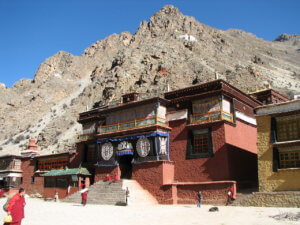
Tolong Tsurphu Monastery (click for attribution-license)
What was Tsurphu like?
It's a very special place. I went there first in 1988, before the Karmapa came. It's a very spare landscape—a very simple backdrop for practice. And yet it's a very powerful place; a natural clarity seems to happen when you come there. Your mind just clears out. There are caves where the previous Karmapas meditated. The living presence of the masters who have practiced there is palpable. Really, that's one of the reasons we go on pilgrimage: the blessings are still there.
Any good stories about the Karmapa?
There are many in the book. But there's one that isn't included. The Karmapa would go for walks in the mountains around Tsurphu. One time he was walking with a group of monks and he walked by a big boulder that was sitting next to the trail. And he just sort of passed his monk's shawl across the face of the rock and the person behind him saw that the name Karmapa, in letters the same color as the shawl—deep maroon—had been written on the rock. When I was there in 1996 I walked up and looked at it and it's very clear: you can see the name Karmapa very clearly. You look at the rock and there are these letters written, with the lichen. It's quite amazing when you see these things with your own eyes. I'm skeptical—all Westerners are—but seeing something like this is impressive.
For more information:
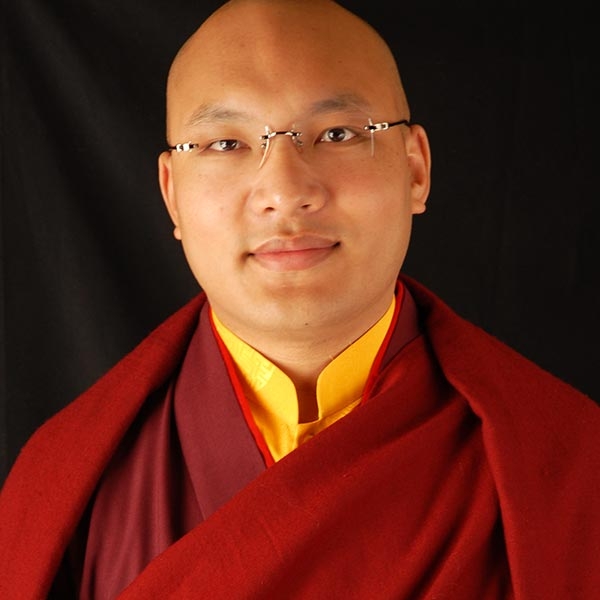
The 17th Gyalwang Karmapa, Ogyen Trinley Dorje, is the spiritual head of one of the major schools of Tibetan Buddhism. The 900-year-old lineage of Karmapas has included some of Tibet’s greatest spiritual masters. Born to nomadic parents in rural Tibet, he was identified while still a young child as the heir to this leadership position. In 2000, the Karmapa’s dramatic escape to India from Chinese-ruled Tibet at the age of fourteen propelled him onto the world stage.
A Buddhist practitioner for over thirty years, Michele Martin has spent the last fifteen years based in Nepal and India studying with Tibetan lamas and working as a translator of oral and written Tibetan. With graduate degrees from Yale University and years of work as an editor, her publications include numerous translations from Tibetan texts on philosophy and meditation and also articles on Buddhism. For the last two years she has translated for the Karmapa and currently lives in the Catskill Mountains of upstate New York.
Related articles:
The Discovery and Recognition of Ogyen Trinley Dorje
Recognizing Reincarnations for Enthronement
...

